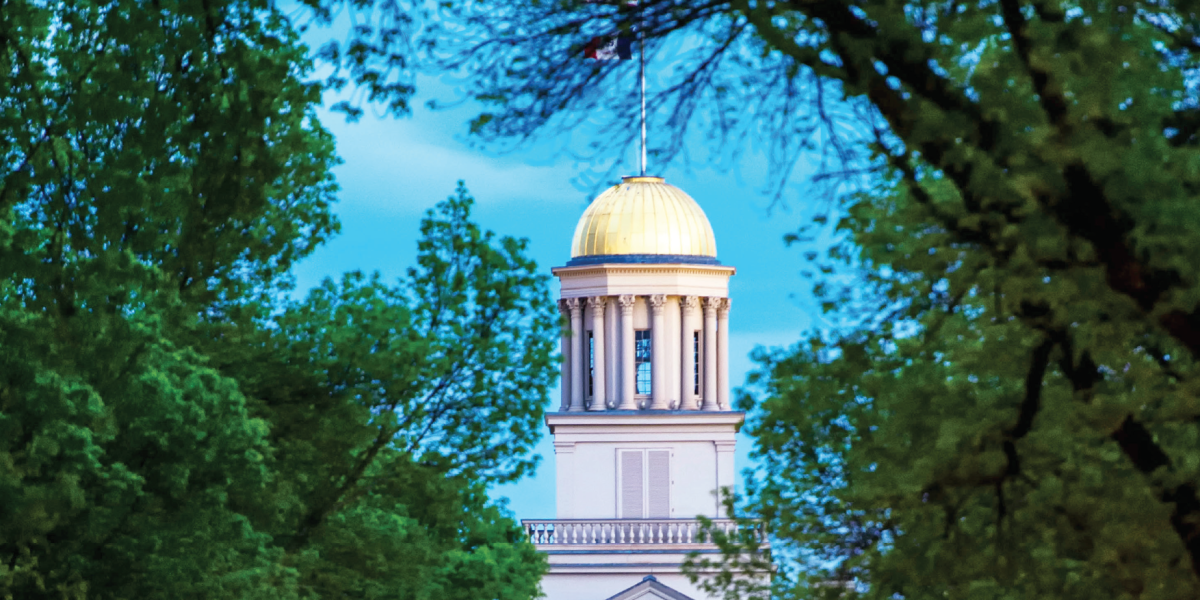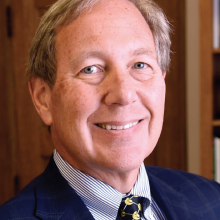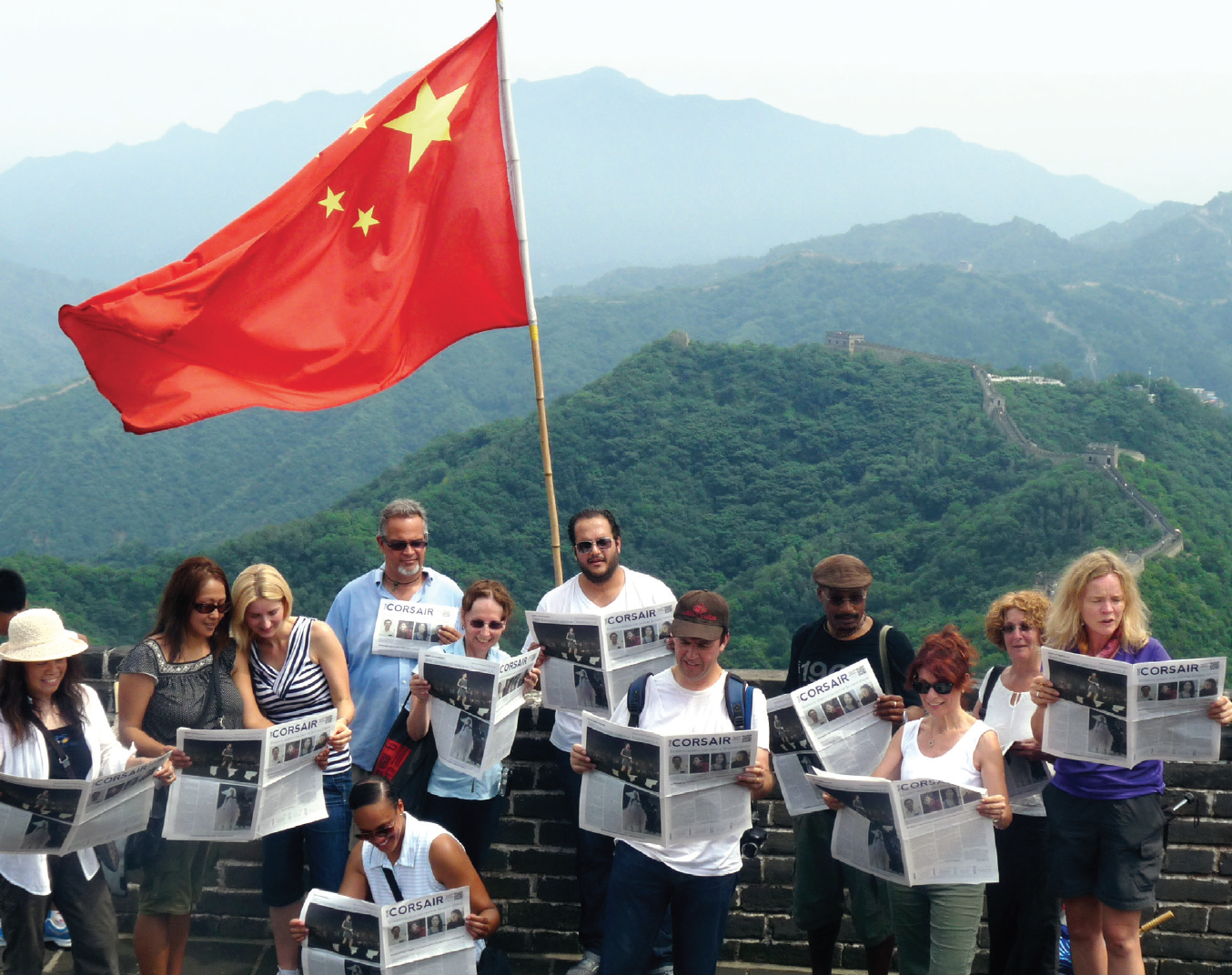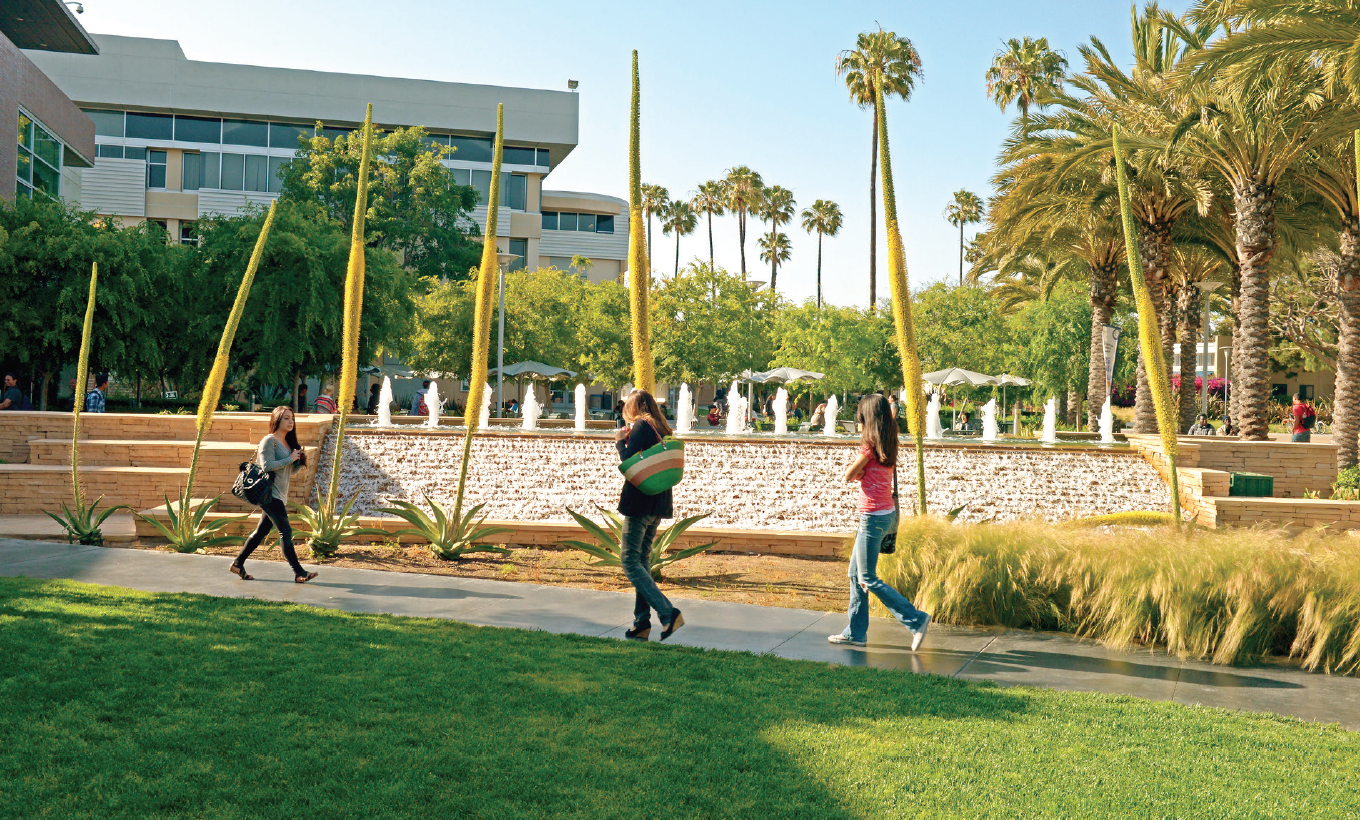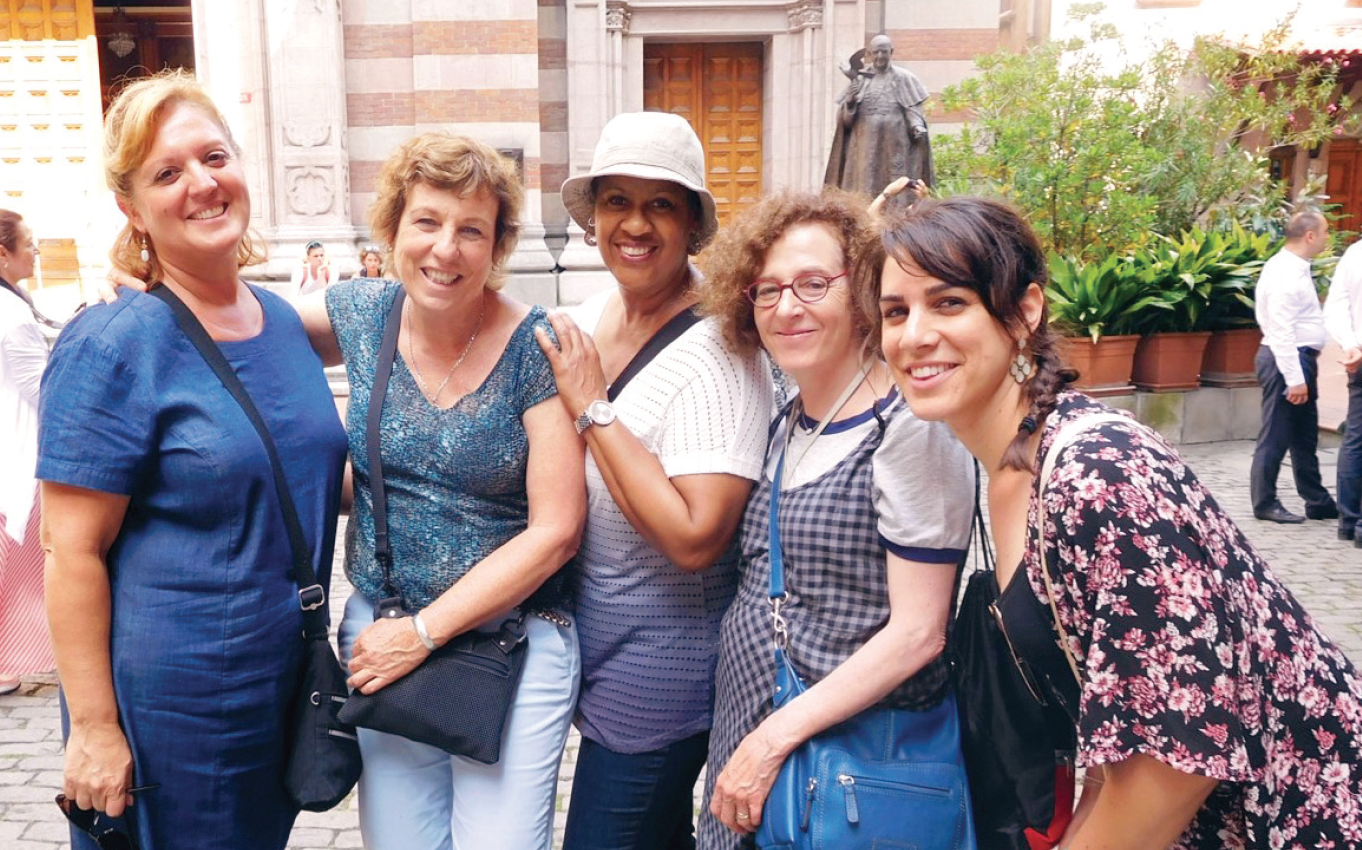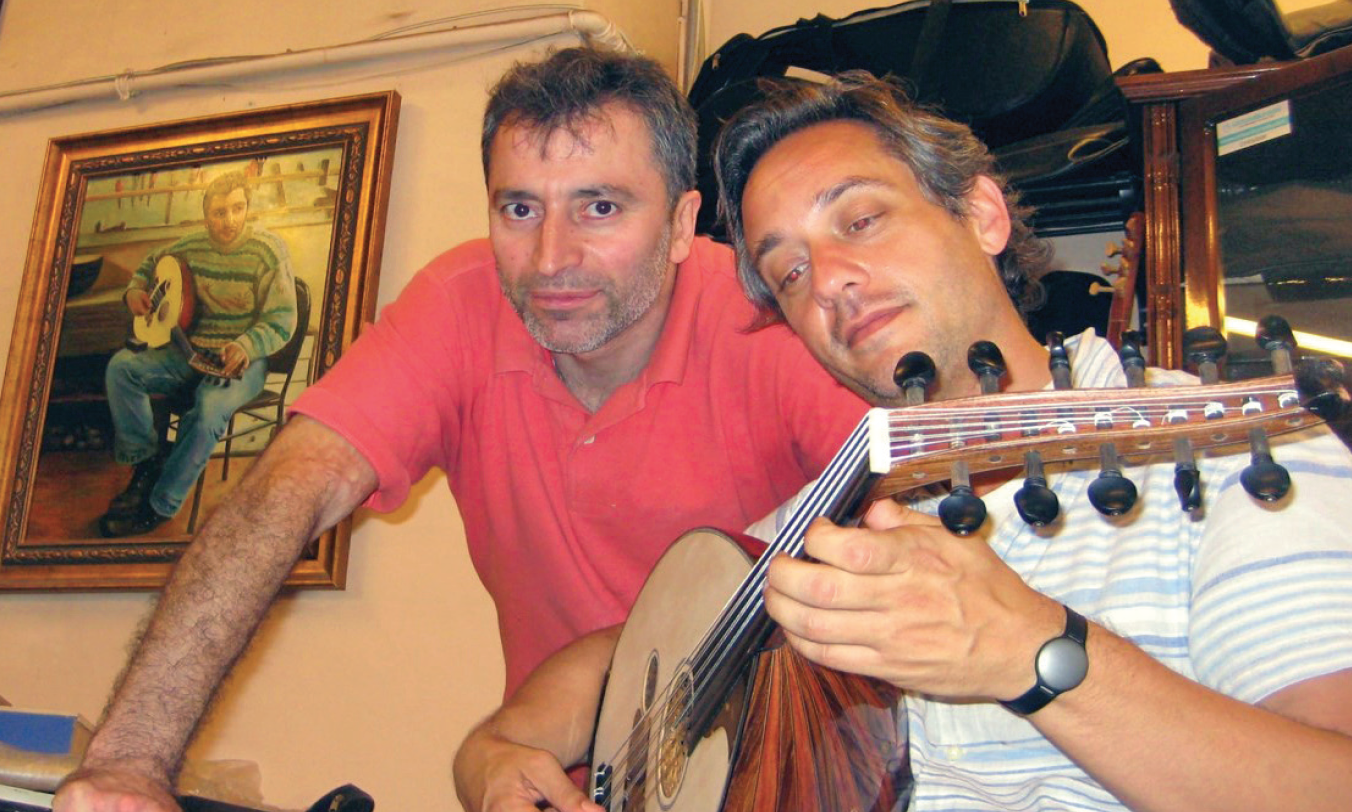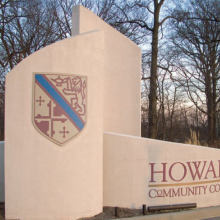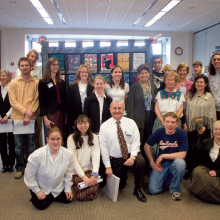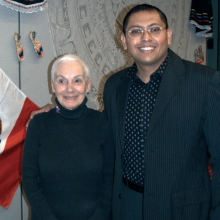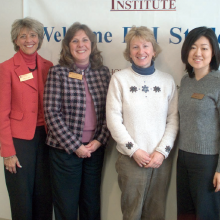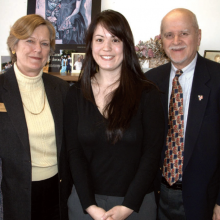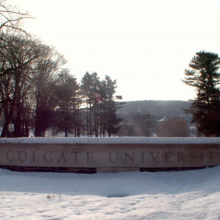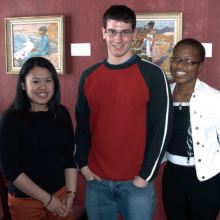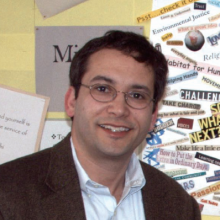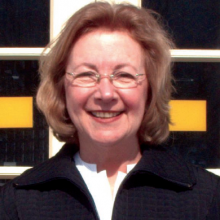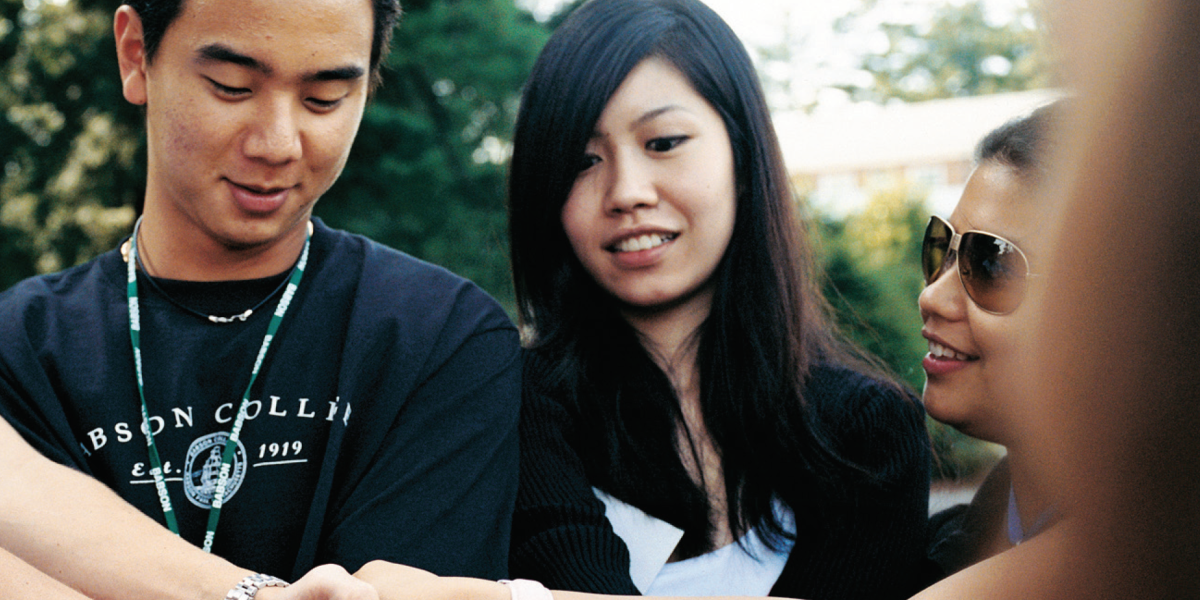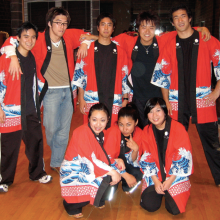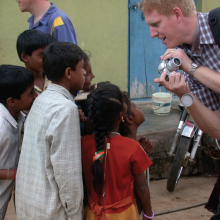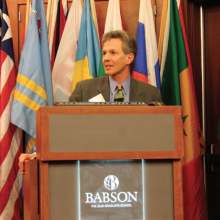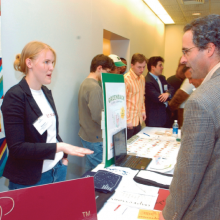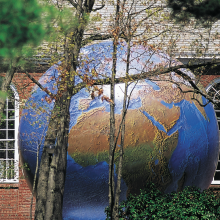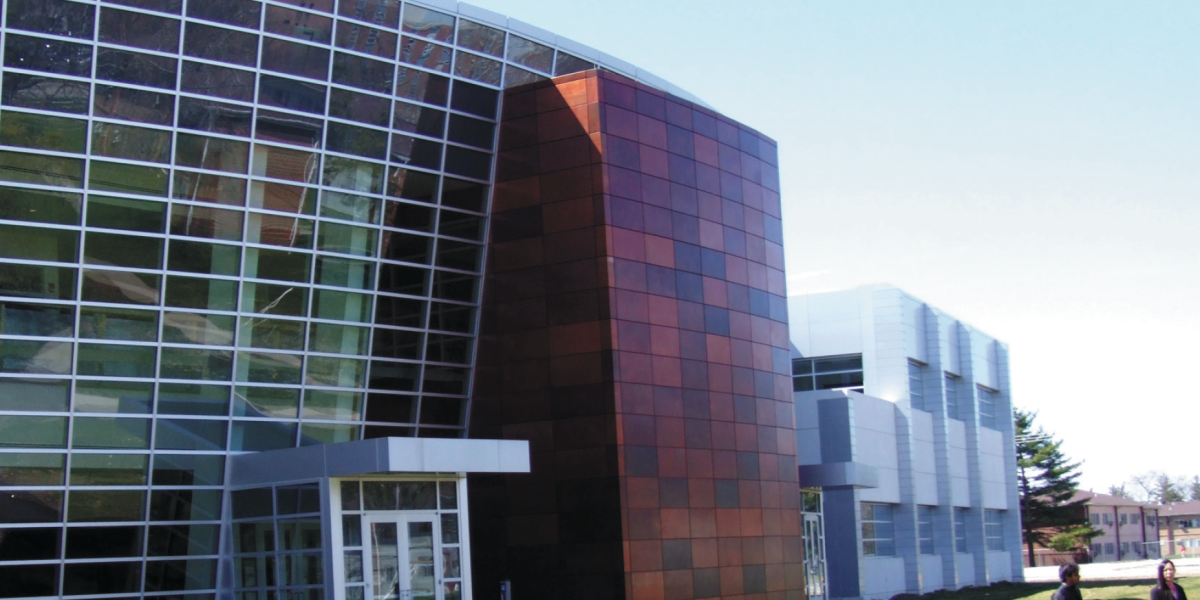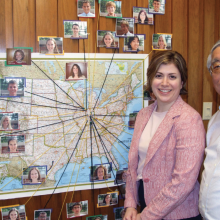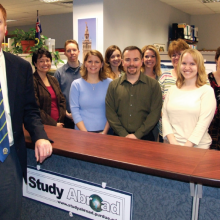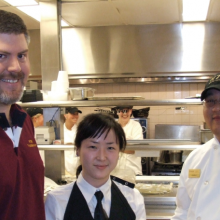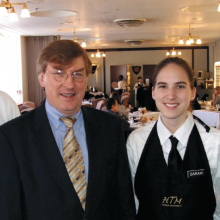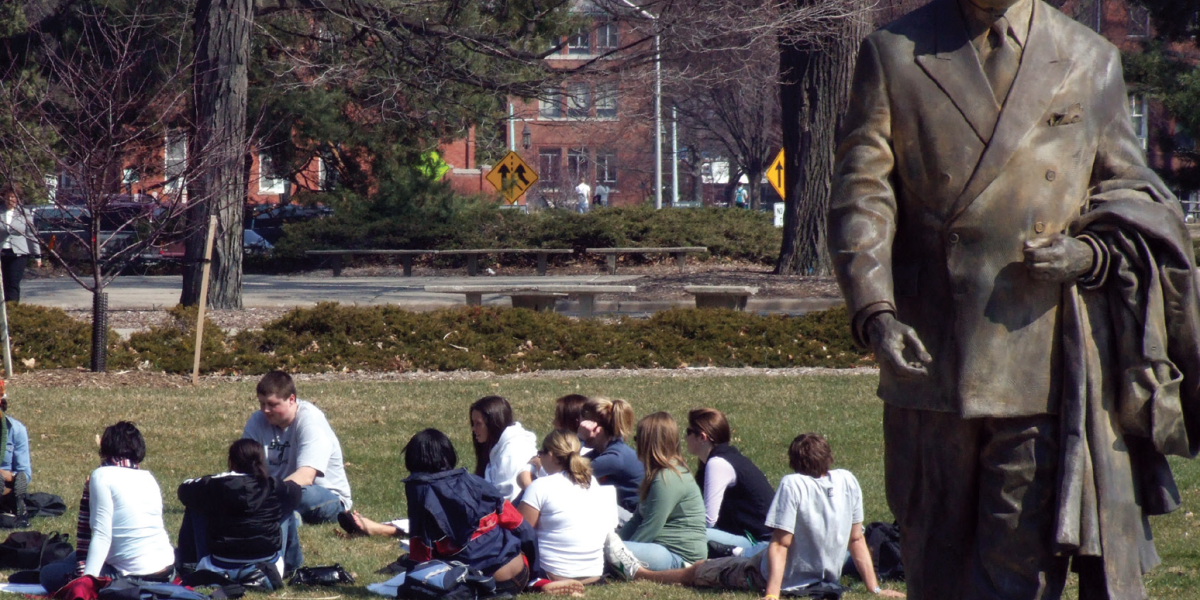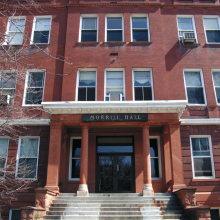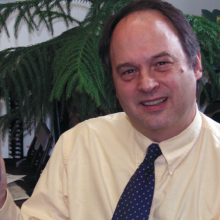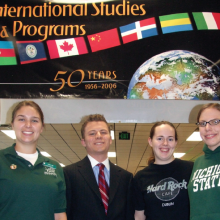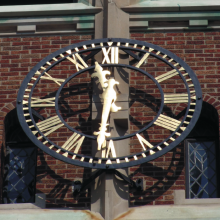Leadership
Responding to a Worldwide Health Crisis and Travel Restrictions
2017 Comprehensive University of Iowa
Through its global initiatives and community outreach efforts, the University of Iowa (UI), well-known for its Iowa Writers’ Workshop, has excelled in recent years in welcoming the world to its campus in Iowa City. The campus, situated on the former grounds of Iowa’s first state capital, is integrated into the heart of downtown. The UI’s 33,000 students—4,300 of whom are international—make up nearly half the town’s population.
Situated in a central location on campus, the UI International Programs (IP) office serves as the hub for international activity. In addition to study abroad and international student and scholar services, IP also offers grants and funding support to faculty and students and provides a number of intercultural training opportunities.
Senior Leadership Pushes the Internationalization Agenda
Internationalization at the UI has been more than 20 years in the making, according to Downing Thomas, PhD, associate provost and dean of international programs. “If you look back 20 years, international activities at the university were largely a boutique operation for students in humanities and social sciences. It’s taken some time to gain momentum, but I think that now we’re seeing that the success and the true value of internationalization occurs when it is riveted to the core missions of the institution,” says Thomas, who also serves as the UI’s senior international officer.
Thomas’s position as dean was created in the late 1990s, when former university president Mary Sue Coleman, PhD, recognized that the institution needed senior leadership to advance its internationalization agenda.
Former provost Barry Butler, PhD, who left the UI in March 2017, adds that Coleman and then-provost John Whitmore, PhD, also provided funding to each college and asked them to come up with creative ways to internationalize the curriculum.
At the time, Butler, associate dean of engineering, used the seed funding to start the Virtual International Project program, which drew on emerging industry practices for working in remote teams. Engineering students were able to collaborate with peers abroad to work on international design projects. Since the initial partnership with Aix-Marseille University in France, the program has expanded to include Hong Kong University of Science and Technology.
Current president Bruce Harreld plans to continue building on the legacy of his predecessors. “Moving forward we hope to be more purposeful in designing an international experience specifically augmenting each student’s on-campus work and career interests,” he says.
Community Outreach As a Cornerstone of Campus Internationalization
A key feature of the UI’s internationalization efforts is its community outreach initiatives. IP currently has seven full-time staff that work exclusively with communications efforts.
“The UI strives to serve not only its students but all citizens of the state. We need to do all we can to share with fellow Iowans the groundbreaking research that happens on our campus and in collaboration with international partners,” says Joan Kjaer, director of communications and relations for International Programs.
International Programs’s signature event is the annual Provost’s Global Forum, which brings together experts from a variety of disciplines to discuss international and global issues.
Full-time faculty are invited to submit a proposal for an award of up to $20,000 to bring speakers to campus. The 2016 Global Forum included an artistic exhibition, a multidisciplinary academic conference, and an undergraduate course on the redefinition of the nation-state in the twenty-first century. The 2017 forum focused on women’s health and the environment.
“It’s an opportunity to focus on a specific issue or topic and have experts from around the country and around the world engaging with our faculty and students,” Thomas says.
Another initiative is WorldCanvass, a monthly radio, television, and Internet program that Kjaer describes as “International Programs’s largest public outreach initiative.” Programs are recorded before a live audience and distributed over television, YouTube, iTunes, radio, and the IP website.
“WorldCanvass conversations are focused on themes that are international in scope. They’re thoughtful, reflective, and inspiring, and we tape the live programs for multiplatform distribution. Interested audience members anywhere in Iowa or the world can enjoy them in the comfort of their home, their office, or their car. We want to reach people where they are and not be limited by time or place,” says Kjaer, who also hosts WorldCanvass.
IP also works with outreach to local K–12 schools. Through the International Classroom Journey program, teachers can enhance students’ understanding of unfamiliar parts of the world by bringing international guests into the classroom to talk about their home countries. For more than 15 years, International Programs and the College of Education have also partnered to present the Teacher’s Institute on Global Education with the goal of helping K–12 educators from around Iowa integrate global perspectives into their classrooms.
Exploring the World Through Writing
Another major outreach effort is the International Writing Program. Since 1967, more than 1,400 writers from more than 150 countries have been in residence at the University of Iowa through its International Writing Program (IWP). The IWP hosts 30–35 well-known authors, poets, and novelists every fall for a three-month residency. Notable alumni include Nobel literature laureates Mo Yan from China and Orhan Pamuk from Turkey.
The IWP, which celebrates its 50th anniversary in 2017, was founded during the Cold War with the goal of bringing together writers from around the world. “It was a place where writers from the Soviet Bloc could meet writers from the west and have free and frank exchanges of ideas,” says Christopher Merrill, IWP director.
Merrill says that since 9/11, there has been a shift at IWP toward a focus on the Islamic world. Because the majority of the IWP’s funding has come from the U.S. State Department and various embassies, much of the program is focused on public diplomacy and cultural exchange.
“After 9/11, we’ve been involved in conversations about the ways in which cultural diplomacy can be a part of the larger diplomatic strategy. And so we started to think of cultural diplomacy as a two-way exchange,” Merrill adds.
As a result, IWP has also started taking groups of U.S. students abroad, hosting symposia in countries such as Greece and Morocco.
To reach an even wider international audience, IWP eventually developed a robust distance-learning program. Since 2012, it has offered more than 30 distinct MOOCs, courses, exchanges, and events on different topics related to fiction, nonfiction, poetry, and plays. In addition, IWP runs a two-week summer writing program at the University of Iowa for young writers, ages 16-19, with workshops taught in English, Arabic, and Russian.
The IWP led the charge in gaining Iowa City’s designation as a United Nations Educational, Scientific and Cultural Organization (UNESCO) City of Literature in 2008. As a UNESCO City of Literature, Iowa City also has an obligation to mentor aspiring cities. Merrill subsequently worked with the Iraqi deputy minister of culture to help Baghdad become a City of Literature in 2015. The connection to Baghdad came out of the connections to the Iraqi literary community made possible through the IWP.
“We like to think we’re helping to jump-start a conversation about world literature,” says Merrill.
UI Creates a Welcoming Atmosphere for International Students
According to the UI, its international student population has nearly doubled over the last 10 years, from around 2,200 in 2006 to 4,300 in 2016. Most of the growth has occurred at the undergraduate level. The top three countries represented on the UI campus are China, India, and South Korea.
To accommodate the growth, International Student and Scholar Services (ISSS) has implemented several programs to support its international population and to promote their integration into life on the UI campus in addition to its standard immigration advising.
One of the initial initiatives in 2008 was the creation of the International Student Committee, which was tasked with auditing existing services and programming for international students to ensure that adequate infrastructure was in place. The committee’s goals have subsequently expanded.
“It drives resources from all units across campus, from housing, public safety, counseling, the registrar’s office, and the colleges to try and make sure that [international students] have the best student experience they can,” says Doug Lee, assistant provost of international programs.
ISSS also runs a number of intercultural programs targeting the wider campus community. The Bridging Domestic and Global Diversity certificate is a leadership program designed to educate students to adapt to cultural differences. Approximately 25 domestic and international students participate in diversity and intercultural training every spring semester. Participants also plan the Bridge Open Forum, an intercultural event to educate the campus about intercultural issues.
The Building Our Global Community certificate is a professional development program that helps UI faculty and staff support international students and scholars. To earn the certificate, participants attend a series of sessions on topics such as helping international students with the cultural adjustment process and the basics of F-1 and J-1 immigration regulations.
The UI also offers individual and group mental health counseling services in English, Spanish, and Mandarin. Students first learn about the University Counseling Service (UCS) at their orientation, when one of the doctors presents about mental health and available counseling services.
“In efforts to meet the needs of students having mental health concerns, the UCS acknowledges that communicating about emotions, insight, and internal conflicts can be highly culturally based and varies greatly due to the construction of how we think about ourselves based on variances within language. As such, the UCS desires to remove as many barriers as possible by providing opportunities for students to communicate in the language that best represents their experience within UCS resource limits,” says UCS director Barry A. Schreier, PhD.
According to Lee Seedorff, ISSS senior associate director, support for using mental health services comes from the students. For example, a group of Chinese students interested in mental health has started a student organization called Heart Workshop, which helps other Chinese students become aware of the support available. Another group is Active Minds, which focuses on mental health awareness and support for both international and domestic students.
In the last few years, the UI has also used technology to reach out to prospective students and parents. According to Lee, it holds welcome sessions in Beijing and Shanghai for incoming Chinese students. To reach students from other countries, they are also creating orientation webinars that students can watch from anywhere in the world. They have also started broadcasting graduations online in Arabic, Korean, Mandarin, Farsi, and Spanish for families who are unable to travel to Iowa City for the ceremony.
The Tippie College of Business, one of the most internationalized schools on campus, has been at the forefront of efforts to integrate international students into life at UI. Around 15 percent of its undergraduates are international, compared with 10 percent on the campus as a whole. To support its large international population, Tippie has created opportunities outside of the classroom such as an international buddy program, which pairs domestic and international students and is open to students from across the campus.
Comprehensive Support for Education and Research Opportunities Abroad
According to the 2016 Open Doors report, the UI ranks in the top 50 U.S. institutions for study abroad, with 21 percent of all undergraduates going abroad. The UI also has several initiatives that create education abroad opportunities for underrepresented students. The total minority undergraduate population is 14 percent, and 16 percent of all undergraduate study abroad participants were students of color in the 2015–2016 academic year.
There are a number of awards available, including a $500 scholarship for traditionally underrepresented populations, such as first-generation students, students of color, LGBT students, and students with disabilities, to help finance study and research opportunities abroad.
IP also recently collaborated with the UI Center for Diversity Enrichment to host the Council on International Educational Exchange (CIEE) Passport Caravan. IP and CIEE sponsored passports for 116 first-generation students and students of color who were first-time passport holders.
International Programs also receives support from the Stanley-University of Iowa Foundation Support Organization (SUIFSO) to fund research projects abroad. Both undergraduate and graduate students, including students who are not U.S. citizens, can apply for international research grants.
In the past five years, 100 graduate students received a total of $250,000, and 26 undergraduates received a total of $59,000 to conduct international research.
“Every year we have a pool of money for students to do preliminary research, or a creative project. They must be abroad for a month and these are a wonderful starting point to apply for a Fulbright,” says Karen Wachsmuth, PhD, associate director for international fellowships and Fulbright adviser.
The UI has been recognized as a top producer of Fulbright awardees for the last two years. In the 2016–2017 academic year, 15 UI students were awarded grants to conduct research or serve as English teaching assistants abroad.
Wachsmuth sees her outreach and recruitment for Fulbright as a springboard to start more general conversations about opportunities abroad, especially early in a student’s academic career. “There are a lot of different programs going on to start conversations, and fellowships are a part of that because they also encourage students to put together their language training or just things that they’ve learned in their coursework and to apply it to an arena that eventually helps them develop their professional goals,” she says.
“The biggest compliment that I get from students is ‘Even if I don’t get this grant, I’ve learned so much about myself and about where I want to go from doing this,’” Wachsmuth says.
Douglas Baker, who graduated in 2015 with degrees in music and Japanese, spent a year in Japan as a Fulbright fellow. He was able to combine his two majors to investigate the work of a nineteenth-century Japanese composer.
He says that the UI’s position as a research institution gave him the resources he needed to prepare his proposal. “The university has many qualified people, from professors to librarians, who know the ins and outs of creating projects or grant writing or conducting research. Karen [Wachsmuth] and International Programs also provide so much assistance in the application process in terms of information sessions, writing workshops, [and] draft writing get-togethers,” he says.
UI Runs Largest U.S. Study Abroad Program to India
The UI’s single largest study abroad program is the India Winterim, an intensive, three-week field-based program held every January. Due to the program’s overwhelming popularity, no other U.S. college or university in the United States sends more students to India. In 2016–2017, 85 students participated in five different courses.
The program is the brainchild of founder Rangaswamy “Raj” Rajagopal, PhD, also a professor of geographical and sustainability sciences. Rajagopal started the program in 2006 and has subsequently sent more than 1,100 students and 60 faculty members to India.
Students are placed at nonprofits and academic institutions through a variety of faculty-led courses in various disciplines, ranging from engineering to art history. Courses have addressed issues such as water poverty, craft traditions, sustainable development, education, and nonprofit management. Students work with Indian partner organizations to learn about their approaches to addressing social issues.
Janice Cousins is a premed and psychology major who traveled to Kerala in South India this past winter break. She took a course titled Pain, Palliative Medicine, and Hospice Care: Learning from Each Other led by a faculty member from the school of medicine. She learned about end-of-life care in India by working with a physician who founded a community-based palliative care program.
“He started this program for people who cannot afford medicine and aren’t getting the correct care. He was really passionate in teaching us about palliative medicine, which considers everything about the disease, including the mental and spiritual aspects. This completely expanded my perspective on medicine. The things I learned in India, I’m not going to learn in medical school here,” Cousins says.
Rajogopal spent six months working with the Indian physician to develop the palliative care course. He says that cultural comparison is one of the key aspects of the program. In the United States, hospice care in an institutional setting is most common, whereas in India, end-of-life care is provided in the patient’s home.
“The lesson learned is that there is no single right model of living life. What we are trying to teach is that America doesn’t necessarily know best. There are different models of evolution, culture, and history,” he says.
Rajagopal says that many students, like Cousins, have come back from India with a desire to go to medical school after participating in courses related to health care.
“All of these kids come back, and they’re renewed. They’re totally fearless. You see people living in extraordinary conditions and doing all these kind of things, and it changes you forever,” he adds.
2017 Comprehensive Santa Monica College
With more than 30,000 students enrolled at its campus in Southern California, including 3,500 international students from more than 110 countries, Santa Monica College (SMC) is one of the most diverse associate’s institutions in the United States. Domestic and international students alike benefit from the college’s Global Citizenship Initiative, which provides a variety of international education opportunities across the SMC campus.
Launched by former college president Chui Tsang, PhD, in 2007, the initiative is a four-pronged strategy that promotes campus internationalization through study abroad, staff and faculty professional development, curriculum development, and international student services. Over the last decade, the initiative has led to the development of several faculty-led programs, an undergraduate research symposium, faculty and staff trips abroad, and a global citizenship requirement for all SMC associate’s degrees.
Global Citizenship Becomes an Institutional Mandate
Dean of International Education Kelley Brayton, who joined SMC in 2008, co-chairs the Global Citizenship Committee with a faculty leader. According to Brayton, “internationalization became a mandate for the institution” under Tsang’s leadership.
The college then convened a task force comprised of faculty and administrators to govern the initiative and to figure out how to make it sustainable beyond the initial funding period. In 2008 the SMC board of trustees adopted the initiative as a strategic priority and committed $200,000 a year for a three-year period. The task force eventually became a permanent standing committee, known as the Global Council, in the faculty senate.
Brayton says the program has been successful due to the support of senior administration, as well as the large amount of financial and human resources dedicated to the initiative. “I have never been at an institution where [internationalization] has had this level of support,” she says.
SMC has continued to provide funding for global citizenship activities, including earmarking $75,000 a year for study abroad scholarships. The college has also successfully pursued two Title VIA grants, which provide federal funding for foreign language, area, and international studies infrastructure-building at U.S. higher education institutions.
Kathryn E. Jeffery, PhD, who became president in 2016, remains committed to the initiative, even in the wake of a state budget crisis. “We are being very guarded around making sure that we continue to support the Global Citizenship Initiative to create opportunities for students. We don’t want that to fall off of the list of priorities,” she says.
Defining Global Citizenship
One of the first steps toward implementing the initiative was defining what “global citizenship” meant for SMC. “Dr. Tsang empowered the campus. He set the direction, but he left it up to us to figure out what exactly global citizenship would look like,” says Gordon Dossett, English professor and one of the original co-chairs of the global citizenship task force.
“Dr. Tsang saw the bigger picture and helped us realize that this was something we could work on as a faculty,” adds Janet Harclerode, chair of the English as a Second Language (ESL) department.
In 2008 SMC adopted its formal definition of global citizenship: “To be a global citizen, one is knowledgeable of peoples, customs and cultures in regions of the world beyond one’s own; understands the interdependence that holds both promise and peril for the future of the global community; and is committed to combining one’s learning with a dedication to foster a livable, sustainable world.”
According to Vice President of Academic Affairs Georgia Lorenz, PhD, the process of defining “global citizenship” eventually led to the adoption of global citizenship as an institutional learning outcome, which has had important implications for accreditation. “For something to become an institutional learning outcome is really significant. At the course and program levels, faculty will map their course outcomes to the competencies related to the institutional learning outcome” she explains.
Faculty-Led Programs Revitalize Study Abroad
When Santa Monica College student Ariana Kirsey traveled to South Africa last year, she couldn’t have imagined that sleeping in a tree house in Kruger National Park would be life changing.
Kirsey is one of 25 students who studied abroad through SMC’s faculty-led program to South Africa in January 2017. In addition to South Africa, SMC also runs annual trips to Belize and Guatemala through its Latin America Education program.
Each year, SMC sends more than 80 students abroad through its various study abroad programs, which range from one-week courses over spring break to six-week courses that are offered during winter or summer sessions.
Although SMC has offered study abroad programs since the 1980s, with the Global Citizenship Initiative the college made a conscious effort to switch from third-party providers to developing faculty-led programs that also allow SMC professors an opportunity to travel.
Every year the college puts out a call for proposals to recruit faculty who are interested in leading trips abroad. Two professors travel with the students on each trip, and both part-time and full-time faculty are eligible to participate.
“We try to have a full-time lead faculty and then have a second faculty who may not have led study abroad before. They colead the first year, and then the second year the idea is that they would take on the lead. We wanted to rotate it so it wasn’t just a select few who could do it,” Brayton says.
SMC also offers a one-credit course, Field Studies Abroad, which launched in 2016. The program was developed specifically to target students who might not be able to travel for longer periods of time. Students travel with a faculty member for seven to 10 days over spring break.
The college approved a one-credit class called Global Studies 35 that can be customized depending on the destination. Brayton says that Field Studies courses have created opportunities for students and faculty alike because of their shorter duration.
Art history major Megan Dobbs says the Field Studies model was quite convenient in terms of time and affordability. She traveled to Denmark in March 2017 as part of a course titled Vikings, Socialism, and Sustainability: Copenhagen Past and Present.
“The trip took me out of my personal bubble and reminded me to think of the world on a much grander scale. This trip continues to remind me that I need to make an effort to step out of my comfort zone and have new experiences,” says Dobbs, who transferred to the University of California-Berkeley in fall 2017.
The college also strives to keep its study abroad programs affordable. “We really work hard on creating very low-cost study abroad. We have become an informal travel agent here at SMC and we work with in-country vendors,” Brayton explains.
The college provides $75,000 in study abroad scholarships every year, and more than half of all students going abroad receive $500 to $2,000 based on need. Many students are first-generation college students, and more than half of SMC’s study abroad participants are minorities. In addition, they are seeing an increased number of international students joining faculty-led programs.
“A lot of our students have never left LA before. Study abroad is an experience that can really shift their perspectives on what it means to be a global citizen,” says Associate Dean of Student Life Nancy Grass, PhD, who led students to South Africa in 2008 and 2012.
Comprehensive Support for International Students
For the last five years, Santa Monica College has had the second largest international student population of any community college in the United States, according to the Institute of International Education’s Open Doors data. SMC attracts students from around the world largely because of its reputation as a top transfer school.
While some students pursue shorter academic certificates, the majority of its 3,500 international students seek admission to nearby four-year institutions such as the various campuses of the University of California (UC). International students receive academic and immigration advising, among other support services, through the International Education Center and the International Education Counseling Center.
Omar Bishr, an economics major from Egypt, plans to transfer to the University of California. “From the moment I applied, the international office responded to all of my concerns. When I came to SMC, I felt like I was really welcomed to the school and that my presence matters. I really liked that I was given a presentation by counselors explaining to me the system of the college and how to choose my classes in order to transfer,” he says.
One initiative that seeks to promote interaction between international and domestic students is a language and culture exchange program run jointly between the modern languages and ESL departments. International students are paired with domestic students studying their language.
“We create an online forum for them and have an orientation. They can meet on that day, but if they don’t then they can go into the forum and introduce themselves and find people for language exchange online,” says Liz Koening, an ESL faculty member.
Approximately 130 students participate per semester. Music major Nahalia Samuels says she took part in order to practice her language skills with a native speaker.
“For me, having a language partner for Korean 1 and Korean 2 made all the difference in my reading, writing and speaking skills. I also wished to learn more about the...culture of the language I’m studying and to offer help as a native English speaker towards my ESL partner. I feel the program helps foreign students to connect with the campus community and expose us domestic students to a seemingly hidden population on campus,” she says.
Professional Development Helps Internationalize the Curriculum
Early on, SMC recognized that it was necessary to internationalize the faculty in order to reach the long-term goal of campus internationalization, especially in the classroom. The Global Citizenship Initiative thus led to the creation of a number of professional development opportunities abroad for faculty and staff.
In 2007, the first group of SMC faculty and staff traveled to Austria to attend the Salzburg Global Seminar, where they learned about topics such as intercultural communication and social justice. Other cohorts have subsequently visited the Beijing Center for Chinese Studies in China and Bahcesehir University in Istanbul, Turkey, with the last group traveling in 2015. Over the past 10 years, more than 125 SMC faculty and staff participated in the professional development programs to Austria, China, and Turkey.
Peggy Kravitz, international education counselor, traveled to Austria, China, and Turkey. “It was a fabulous way to learn about those cultures, which of course I deal with in my work with international students,” she says.
Grass, who traveled to China, adds that one of the greatest benefits of the programs is the fact it was open to all full-time employees on campus.
“It wasn’t just faculty or administrators who could go, but technicians and custodians could apply as well. They really took a cross-section of the college that allowed for people to really get to know each other in a whole new way,” she says.
Brayton says the idea was to help staff who are often on the front line of student services gain a greater appreciation for the international student experience at SMC. “Classified staff are the ones who have a lot of casual interactions with students every day. The more they understand some of the challenges of being abroad, the more they that can connect with our international student population,” she says.
Upon their return to campus, faculty members must develop modules for their courses, and staff are to participate in international activities on campus, such as International Education Week.
In addition to the trips abroad, faculty can apply for a number of Global Grants ranging from $3,000 to $10,000 that fund projects and events, such as speakers, film screenings, and field trips, throughout the year. Harclerode, for example, received a Global Grant to take her ESL classes to various sites around Los Angeles, including the Watts Towers and the Los Angeles River. “The idea was to take them to the parts of LA they might not get to on their own,” she says.
Promoting Global Citizenship Through Student Research
To weave the idea of global citizenship into the fabric of campus life, SMC chooses a theme for each academic year and encourages faculty to develop related course modules. The current theme—“Gender Equity: Is Equity Enough?”—has been running for two years. In 2017–2018, the campus is exploring the topic of “Promise and Peril of a Global Community.” Previous years’ themes have included water, food, poverty and wealth, and peace and security.
The campus also holds an annual research symposium, where students are invited to submit and present academic and creative projects related to the annual academic theme.
Grass, who chaired the first symposium in 2010, says the idea for a campuswide research symposium emerged from the need to better prepare students to transfer to four-year universities: “When students come from the community college, even if they are really well prepared academically, they’re not ready to jump into junior-level research projects. Having the symposium encouraged faculty to have students do original research around this idea of global citizenship.”
“When we put out the call for proposals, it allows students to put forward what global citizenship means to them in the context of their education,” adds Delphine Broccard, communications professor and current symposium chair. “We can really discuss what global citizenship means in the different disciplines.”
Students submit proposals for projects ranging from short films, persuasive speeches, and photography to responses to study abroad experiences and Science, Technology, Engineering, and Math (STEM) research. Students can win cash prizes for the best entries in different categories. In 2016, Kenta Tanaka, an international student from Japan, won the President’s Award and $500 for a design project that explored the theme of gender equity in fashion. “I mixed menswear and womenswear. In fashion, we call it gender blur,” he says.
Global Citizenship Spans the Curriculum
SMC has used funding from one of its two Title VIA grants to develop a global studies major. Global studies at Santa Monica is an interdisciplinary program designed to increase students’ knowledge and understanding of the processes of globalization and their impacts on societies, cultures, and environments around the world. Coursework includes world geography, international political economy, experiential learning, and foreign language.
The Global Citizenship Initiative has also given impetus to the development of a global citizenship degree requirement for all students receiving an associate’s degree. Students can meet the requirement either by studying abroad or taking an approved global citizenship course.
“The reality is that not a lot of students can participate in study abroad. But where students are going to be the most impacted by global learning is in the classroom. Infusing global perspectives into the general education curriculum is where we can reach a lot of students. Hopefully, that exposure highlights some of the international opportunities for them, not just here at Santa Monica but beyond,” Brayton says.
Management Development Program (MDP) Trainer
2005 Comprehensive Howard Community College
Near the end of the faculty’s first meeting with Mary Ellen Duncan after she became president of Howard Community College in 1998, Spanish professor Cheryl Berman stood up and asked with unwonted diffidence, “Can I start study abroad programs here?” “You don’t have study abroad programs? Of course, you better start study abroad programs,” replied Duncan, a onetime high school Latin teacher who had previously expanded the horizons of SUNY’s College of Technology at Delhi during seven years at the helm of that school in New York’s Catskill Mountains.
Today Howard Community College regularly sends dozens of students on a Spanish immersion program in Cuernavaca, Mexico, each January, and it offers opportunities to study in China, Italy, Greece, Russia, and Costa Rica. It has student and faculty exchanges as well with institutions in Denmark and Turkey, awards scholarships for study abroad, and has partnerships with Dickinson College and the College of Notre Dame of Maryland that allow top Howard students entry to additional summer programs on several continents.
A Very Internationally-Oriented Community College
Howard’s World Languages department—Cheryl Berman is the director—regularly teaches Arabic, French, German, Italian, and Spanish, and through its Critical Languages program provides tutors and online resources for students to learn Chinese, Russian, Korean, and Greek. It has a thriving English Language Institute, as well as 174 international students among the 6,700 students seeking associate degrees. Howard faculty, administrators, and even its board of trustees are active in Community Colleges for International Development, Inc., a consortium of 90 community colleges involved in exchanges and development projects in more than 40 countries. Duncan chaired the consortium in 2005.
Howard is in the midst of a building boom, with work completed on a high-tech Instructional Laboratory Building, a performing arts complex well under way, and a $28 million student services building in the offing. Howard was born in 1970 with advantages, sitting in the middle of one of the wealthiest counties in the United States, midway between Washington, D.C. and Baltimore. Columbia, its hometown, is itself an experiment in living, a planned community created in the turbulent 1960s by developer James Rouse, known for revitalizing Baltimore’s Inner Harbor and breathing new life into Boston’s Faneuil Hall, as a place where all races and classes could live and work together, with parks and pathways and a small-town atmosphere. It has not worked out entirely as Rouse dreamed; most of Columbia’s 100,000 residents commute to jobs in Washington and Baltimore.
Howard Community College is only the seventh largest of Maryland’s 16 community colleges, but enjoys an outsized reputation as a place that cultivates and rewards innovative thinking, from entrepreneurial workforce training programs to a much honored theater program that boasts the only professional Equity theater group in the country at a community college. The president and vice-president of the student government last year were from Germany and Syria respectively, and Howard has garnered several national awards for internationalizing its curriculum. Duncan said it is fitting for a place founded as a “little Shangri-La. We’re in a community that has people from all over the world.”
Faculty and Administration Work Together on Internationalization
The emphasis on the international spread throughout academic departments after business professor Rebecca Mihelcic became coordinator of international education in 1999. Vice President of Academic Affairs Ron Roberson, a former chair of the humanities division and fine arts professor, said, “When Beckie expressed an interest in really going after the development of an international education program, I was very excited.” Roberson, who spent a year as a Fulbright scholar painting and studying art history at the University of Louvain in Belgium after his graduation from Morgan State University, added, “Nothing happens in education unless you’ve got somebody on fire about an issue. Beckie had the conviction that this was a critical direction for the institution.” Mihelcic built on groundwork that Margaret M. Mohler laid as director of the International Business and Education Center from 1995 to 1999 at Howard. But Mihelcic cast the net wider, encouraging faculty in every program to take advantage of international travel and research opportunities and to incorporate international content into their classes.
Patti English, who 10 years ago started Howard’s cardiovascular technology program, which trains technicians to work in cardiac cath labs in leading Baltimore and Washington hospitals, remembers getting a survey from Mihelcic five years ago encouraging faculty to think of ways to internationalize their courses. She sent it back with a note saying, “Beckie, I would love to, but I can’t foresee anything in my field being international.” When pressed, English recalled that some countries had approached her professional association for advice on setting up cardiac cath labs. “Patti, what do you think of that?” asked Mihelcic.
In January 2004, English and Jeanette Jeffrey, an assistant professor of health science who teaches nutrition and community health, took four students to Costa Rica for a comparative study of the country’s healthcare practices. They visited public and private hospitals and clinics, and will be returning with more students in 2006.
“Everyone is incredibly supportive of internationalizing Howard, from the president on down,” said Jeffrey, who also teaches at the University of Maryland, Baltimore County. Last year Roberson gave her a professional development grant to do field research in Switzerland under the auspices of UMBC’s health administration policy program.
“You have to get the faculty on board before you get the students,” said Mihelcic, who raised $6,000 last year for study abroad scholarships by renting to colleagues a rustic cabin she owns. “Once faculty start thinking in international terms and they start talking international, it becomes a natural thing. It’s not something we’re adding to the curriculum. It’s something that’s part of our education.”
Offering Students Mirrors and Windows
Helen Buss Mitchell, a philosophy professor and director of women’s studies, always had been passionate about exposing philosophy students to the widest possible range of thought and beliefs about existence, not just the Western tradition. When she complained about the deletion of women’s voices from a popular philosophy textbook in the early 1990s, the publisher’s representatives asked Mitchell to write her own textbook. The result was Roots of Wisdom, now in its fourth edition and being translated into Chinese and Spanish. Mitchell also produced a television course, “For the Love of Wisdom,” distributed by PBS. “My life has taken quite a different turn and it’s been wonderful,” said Mitchell.
Mitchell said Howard Community College’s internationalism is partly a product of “where we are, between Baltimore and Washington. We’ve got embassies 25 minutes away, and events of all kinds. We’re positioned in a place where the world comes to us, and we make a special effort to be, in Diogenes’s famous phrase, ‘citizens of the world.’”
“Twelve years ago, when I first started teaching ‘Religions of the World,’ most people in the class were Christians or a few Jews, that was it. Now every semester I’ve got Muslim students in the class and often Hindu students,” she said. “It makes for very interesting discussions.”
At Howard, Mitchell said, “We offer our students mirrors as well as windows. We want our students to see through the windows into whatever it is we want them to see. But we’re offering mirrors as well so that in my book and in a lot of things going on here, students see themselves reflected.”
World Languages Program
The college renamed its “foreign” language program “world” languages several years ago. “I love that,” said President Duncan, who took the Spanish immersion classes in Cuernavaca herself. “‘World’ languages sounds much more inviting.” The college celebrated World Languages Day last March with a day- and eveninglong series of 15 events ranging from skits and songs to lectures and a Chinese calligraphy demonstration (Cheryl Berman served as the impresario, wearing a peasant dress she brought back from Chiapas, Mexico). To accommodate day and evening students, the dancing, yodeling, mariachi music, and more went on from 10 a.m. to 2 p.m. and again from 5 p.m. to 9 p.m. The language classes , draw students of all ages, from teenagers to octogenarians. “Cheryl is such a strong and joyful force, drawing people into the culture and languages,” said Jean Thiebaux, a retired mathematician for the National Oceanic and Atmospheric Administration who has taken Spanish classes here and in Cuernavaca.
The immersion classes in Mexico are taught at Universidad Internacional in Cuernavaca, which arranges stays with host families for students from many U.S. colleges and universities. Jonathan Henry, who works in international promotions for the Mexican university, said, “To me, Howard seems like a regular university.”
Universidad Internacional sent faculty member Carlos Guzman on a one-semester teaching exchange to Howard in 2003. His courses were so popular that Howard asked him to stay for a second semester, and then for a second full year. “This will be my last [semester]. It’s time for other faculty to have the opportunity,” said Guzman.
Berman was a French major in college whose interest in Spanish was awakened when she and her husband adopted twin girls from Bogotá, Colombia. “I fell in love with everything Spanish, with the cultures, the whole thing,” she said.
Berman has a gift for picking up languages—and for convincing others to give it a go. “You just have to role model passion and energy and expectations and all those things, and they pick and choose what they take out of it,” said Berman.
When Berman set out to explore the first study abroad opportunity for Howard, a Spanish professor from a State University of New York campus shared a wealth of advice about finding immersion classes in Latin America. She also informed her about the myriad of details related to preparing students for the experience—everything from shots to release forms.
Partnerships with U.S and Danish Governments Bear Fruit
Howard’s critical language program grew in part out of Berman’s interest and involvement in the Interagency Language Roundtable (www.govtilr.org), a half-century-old network of federal agencies that share information and resources about teaching and learning languages. Howard hosted a Roundtable meeting in April that explored the roles of community colleges in delivering foreign language education in the United States, and the Roundtable also held its annual summer research showcase at Howard in July 2005.
The government has identified six languages as critical to U.S. national security—Korean, Chinese, Farsi, Russian, Spanish, and Arabic—and Howard now offers regular or special instruction in five of them. Berman believes that since these languages have been identified as a national priority, educators and schools at every level should do their part to teach them. The students in a Korean or Chinese critical language tutoring session at Howard may never end up at the Defense Language Institute’s Foreign Language Center in Monterey, California, but they could become part of a groundswell that produces more candidates for advanced training. “It’s like a [youth] soccer league, you know? One that has both travel teams and the neighborhood kids?” said Berman. “It’s like, ‘Everybody—high schools, community colleges, four-year colleges and universities—just put in your players, and somehow enough will emerge at the top.’” At Howard, she added, “we’re the neighborhood squad, and that’s how I like it.”
Howard got a Danish connection thanks to a State Departmentarranged visit by the Danish education minister. Roberson was invited to a conference in Denmark with other community college representatives. He and representatives from three Danish colleges eventually decided to develop an information technology exchange program. “I thought that would be the easiest thing around which to develop an articulation. The skill sets and the software are the same, regardless of where you are; you’re still dealing with Microsoft and Apple,” he said.
“I proposed a tactical project that we could do ourselves, regardless of whether we got external funding,” said Roberson, whose office is filled with portraits he has painted in styles from that of Rembrandt to stark realism.
Faculty from the three Danish institutes—Neilsbrock Copenhagen Business College, Odense Technical College, and Tietgen Business College—visited Howard and jointly worked out the articulation agreement so that Danish students could spend their third semester in Howard and U.S. Information Technology (IT) majors could spend a semester in Denmark, where IT courses are routinely taught in English.
What do the Danes have to teach U.S. students headed toward careers as programmers?
“It was really happenstance, in all honesty, that this partnership was with Denmark,” Roberson said. “The fact is, though, that the year that their minister of education visited our campus, their business and technical school system won the prize as the best in the European Union. I was very curious how it was [that] they were organizing their programs. We have learned quite a bit from our collaboration. They design programs very differently. They have a holistic design. We offer a menu list and students pick from that menu. Their holistic approach was very interesting to us, the fact that they taught business and marketing and entrepreneurship as part of their IT programs. What IT program in the United States does that?”
Long-term internships were also built into the Danish regimen, so that after a year of classes, all students spent an entire semester working in industry before returning for another semester of coursework. “They really are very connected with the industry. They learn not only the abstractions of the education program, but they actually understand how it works in the real world,” said Roberson.
“The fruits are really just beginning for us. We sent our first student over last fall; they have sent seven so far,” he said. The Howard student, with support from the community college, studied multimedia design in Odense—birthplace of Hans Christian Andersen, two hours by train from Copenhagen—and “had a wonderful experience.” The Danish exchange students, meanwhile, who had been taking English since elementary school, all placed into college-level English at Howard and excelled in their studies here. The community college, which has no dorms, rented an apartment for these exchange students. “For the Danes, this is nothing special. They have many of these agreements with many different countries. The students have a lot of choices. We represent another choice for their students,” said Roberson.
Consortium Teams with Turkish Technical Colleges
In consortium with Delaware Technical & Community College and Northampton College in Bethlehem, Pennsylvania, Howard is now attempting to forge an extensive partnership with technical colleges across Turkey. Howard will be lending its expertise in preparing English as a Second Language (ESL) teachers as well as in teaching computer sciences, while Delaware Tech and Northampton will impart their expertise in other areas. Vice President of Student Services Kathleen Hetherington and ESL Director Jean Svacina made an exploratory trip to Greece and Turkey in 2002 under the auspices of Community Colleges for International Development. Rebecca Price, the ESL program administrator, was headed to Turkey this spring along with a team of Howard administrators to work out the details and to gauge whether the Turkish computer science students were ready for English-language instruction at Howard after a year of studies at their home institutions. Howard also was sending four students and a faculty member to study in Ankara in June 2005.
The English skills of the Turkish students are not as advanced as those of the students in Denmark. Price, whose ESL program has won both state and national awards, said, “They may need to do a semester here in our language institute, or we may have to go train their teachers so that the instruction they get in English is better before they come here.”
“The Turkish government is totally committed to this. This is not just a couple of schools. If it works, this will be a program available to all two-year schools in Turkey,” she added.
Working with Local Business and Industry
The Howard Division of Continuing Education & Workforce Development has a long history of responsiveness to the needs of Maryland businesses. Patricia M. Keeton, executive director of workforce development, said, “Many Howard County companies are trying to internationalize their business. We have a contract right now with a local company to train 25 Kuwaitis in fundamentals of electronics this summer in order to help that company then teach them how to use their equipment. We’re able to assist businesses in translation efforts, we’re able to help them train employees who speak English as a second language.”
Minah Woo, a program counselor in the English Language Institute (ELI), said one reason its enrollments have grown is that “we have four levels of classes and a variety of classes at each level. We’ve established ELI custom class options. The student who won the scholarship to art school was taking nine credits of ELI and three credits of art class.” Some institute students bound for U.S. graduate or professional schools come to Howard’s ELI after scoring over 600 on the Test of English as a Foreign Language.
“Students come and say, ‘I have a real need in public speaking.’ Others say, “I can speak fine, but they don’t understand my pronunciation,’ or they come and say, ‘I need to do more professional writing.’ They can come here and take the classes they need, whereas other institutes basically have morning writing and grammar and afternoon reading and conversation.”
JoAnn D. Hawkins, associate vice president of the Division of Continuing Education & Workforce Development, said tool manufacturer Black & Decker is sending executives to Chinese classes at Howard so they can communicate with employees at a plant in Soochow, China. “They found that when they went over, even though they had translators with them” some of what they said was lost in translation. Her division also is set to help a company that trains firefighters for Malaysia produce the country’s first emergency medical technicians. That would involve sending two Howard instructors to Malaysia for five weeks over the summer, then hosting a dozen or more trainees here for five more weeks.
Hawkins, who used to lead study trips to Europe and Asia that the college organized for community members, said the spirit of cooperation between the credit and noncredit sides at Howard is unusual. “We don’t have silos. Whoever can do a program best does it,” she said.
Vladimir Marinich, a Howard history professor, and his wife Barbara Livieratos, the associate director of research, regularly take students and other community members on a study trip to Russia that is built around a cruise on the Volga between Moscow and St. Petersburg. They have devoted profits from the trip to a study abroad scholarship fund and have raised $40,000 on four trips since 2000. Kristy Herod, 25, won a $3,200 scholarship that paid for her trip to Russia. The Hawaiian-born Herod, now pursuing her bachelor’s degree at the University of Maryland, said, “There’s nothing better than actually being able to say, ‘Well, I read this in a book, but this is where it happened and here I am.”
Scholarship Students Are Looking for International Experience
The Rouse Scholars Program—named after the founder of Columbia—has long been a source of pride for Howard. Barbara Greenfeld, director of admissions and advising, said the selective admissions program “is unique among community colleges across the nation.” It was begun 13 years ago and its reach has been extended by a partnership with Dickinson College in Carlisle, Pennsylvania, that allows Rouse scholars to go on Dickinson summer study abroad programs. Dickinson, which was featured in the NAFSA’s Internationalizing the Campus 2003 report, runs 35 study abroad programs in 22 countries on six continents. Patrick Ginssinger, a 2003 Howard graduate, went on an archaeological dig in Scotland with students from Dickinson and the University of Durham. Hafsa Bora ’05, who went to Dickinson’s center in Bologna, Italy, in summer 2004, said, “I loved everything about my … summer study abroad experience. I learned so much and can hardly wait to return.” Other Rouse scholars have studied in London and Hong Kong, in some cases with tuition waivers or reductions. Howard also has formed a study abroad partnership with the College of Notre Dame of Maryland.
Greenfeld said Howard regularly asks its Rouse scholars what they were looking for in a college. In recent years, the answers were clear. “They want housing and they want an international travel experience, and they want to know how we’re going to provide that for them,” she said.
Providing the Encouragement and Support for International Programs
Howard is considering building its first dorms not just to keep attracting top caliber local students, but to make it even more inviting for international students. The lack of dormitories has been an obstacle the college has had to overcome in forging partnerships, both with the Danish colleges and a new arrangement with Soochow University in Suzhou, China. But Howard hasn’t let that curb its momentum.
There’s a lesson in that for other colleges, said Kate Hetherington, who is herself a graduate of and former administrator at the Community College of Philadelphia (also featured in Internationalizing the Campus 2003). Obstacles can be overcome. “Opportunities do show up at your doorstep, and when they do, it’s a matter of saying, ‘Let’s give this a try,’ rather than, ‘No, we don’t have housing,’ rather than looking at all the nos,” said Hetherington. “There’s been a lot of freedom [at Howard] for people to explore ideas around the theme of global education….Essentially we’ve asked people to let their creative juices flow and given them the freedom and support to go ahead.”
Building Connections with China
Roberson traveled to China in 2004 in quest of new partners. When Duncan was president of SUNY Delhi, her hospitality program exchanged students and faculty each year with a partner in China. As the president said of her receptiveness to creating study abroad opportunities at Howard, “It’s hard working in China, but I couldn’t believe that this community wouldn’t want that experience for their children.”
Qing Qing Li, a professor of English at Tianjin University of Commerce in China, spent a year at SUNY Delhi teaching Chinese culture classes a decade ago, and President Duncan invited her to reprise that role at Howard this past year. Li, whose education was disrupted by the Cultural Revolution in the 1970s, said she has gained insights at Howard that will help her students back in Tianjin. She is auditing Helen Mitchell’s “Religions of the World” course and deepening her knowledge of Western culture.
“I grew up in the ’60s and 70s in a kind of culture vacuum. I did not really know much about my own culture,” said Li, who demonstrated the art of Chinese calligraphy as part of Howard’s World Languages Day. “My education was like everyone else’s. We didn’t study the normal courses; we were doing the political things. We spent a lot of time in the countryside and in the factory to be reformed.” It was only “after I learned English [that] I realized that Chinese, my own culture, was just as important. So this coming to America to teach about Chinese culture is really my journey to return to my roots,” Li said.
Roberson has arranged to send a group of Chinese language students to a summer immersion program at Soochow University in Suzhou, China, in 2006. That partnership grew out of an American Association of Community Colleges conference that he attended in 2004, where he made contact with three institutions interested in opening their doors to U.S. students. Soochow offered the best deal—tuition and room and board for a month for just $750—and Roberson returned to China this spring to finalize the arrangement. A new community college in Shanghai is hoping to form a partnership with Howard’s English Language Institute and develop an international business and marketing course that Howard could cosponsor in Shanghai. Again, as he did in Denmark, Roberson looked for ties that were practical and that two institutions 7,400 miles apart could manage on their own. “You don’t want to go to China without knowing what you’re doing because you can do a lot of toasting and bowing and come back with nothing,” he said.
Countering Trends: Growth in ESL
Howard’s English Language Institute has grown in the past four years even as similar programs on many U.S. campuses have seen enrollments slump due to visa restrictions and increased competition from other English-speaking countries. The English Language Institute started with six students in 2001; this year it enrolled 90, including 77 international students on F-1 visas and 13 permanent residents. The intensive instruction—typically 18–20 hours per week—is geared for those interested in boosting their English proficiency as rapidly as possible. The institute can custom-tailor courses to a student’s particular interests and needs, as it did for June Eun Song, an aspiring artist from Korea, who after three semesters at the institute won a $30,000 scholarship to the Cleveland Institute of Art.
The institute is just one part of Howard’s large, robust English as a Second Language program, which enrolls 1,400 non-native speakers—mostly permanent residents of Howard County who are part of a growing population of immigrants from Korea, Latin America, and other parts of the world—in noncredit courses, and 400 others taking the same classes for academic credit. The noncredit and credit work closely together with a wide range of students who need better English skills, from professionals with advanced degrees to blue-collar workers. Some students are readying themselves to matriculate at Howard or four-year colleges; others already possess a college degree but are preparing for graduate school at Johns Hopkins University and other top institutions.
An Action Plan for Continued Growth
Howard Community College’s internationalization proceeds apace on multiple fronts: a rapidly growing English Language Institute; more opportunities for students to study abroad and more teacher exchanges; support for faculty to deepen or develop international expertise; and an entrepreneurial continuing education division that casts a wide net for training opportunities. Its journey is far from complete. It is just beginning to consider how to implement the charge it received from a citizen’s Commission on the Future “to make a clear and visible strategic commitment to international/intercultural competence.” A Multicultural Plan Committee headed by Kate Hetherington has produced a blueprint that includes stepping up international requirements, more faculty exchanges, and, if and when dorms are built, expanding the Multicultural Center and opening a “world café” for people to meet, eat, and exchange ideas and experiences. With Beckie Mihelcic phasing into retirement—she handled the international duties parttime in addition to teaching—Howard has hired as the first full-time director of international education George Barlos, an attorny who formerly directed international programming and study abroad at the University of Dayton and Tulane University. It also hired a fulltime assistant, Christele Cain, who holds twin degrees from Howard in graphic design and mass media web production.
2005 Comprehensive Colgate University
The origins of Colgate University’s elaborate array of off-campus study programs can be traced not to London or Paris or Venice but to Washington, D.C., where the liberal arts college dispatched a professor and handful of students during the Depression to see for themselves how President Franklin D. Roosevelt and his New Deal were reshaping the executive branch. The trip became a regular feature of Colgate’s political science program: while the Hamilton, New York, campus was still deep in winter’s grip, a faculty member would lead a contingent of juniors or seniors south to deepen their understanding of the U.S. system of government, often with Cabinet secretaries, leaders of Congress, and other senior officials serving as docents.
Education Abroad is Part of Colgate’s Character
Colgate earned the distinction of becoming the first of many U.S. colleges and universities to offer a semester in Washington; the program observed its seventieth anniversary in 2005. The private undergraduate institution sitting squarely in the rural middle of New York State saw that this model of sending a professor and students away for 12 weeks to teach, study, and learn together could be applied equally well in more distant parts of the world. In the 1950s, a study group headed off to Argentina. Later came study groups to Europe and Asia. Today this modest-sized institution (enrollment: 2,750) offers up to a dozen Off-Campus Study Groups each semester around the globe, from London and Madrid to Chennai, India, and Wollongong, Australia.
Ten percent of the 267-member Colgate faculty venture off campus each year with Study Groups or on briefer Extended Study Groups, which allow students to see the places they studied in Hamilton, from the back alleys and markets of modern Beijing to excavations in Rome and Pompeii. A Colgate professor teaches one or two courses to the study group, typically 14 students, and the students take two or three more at local universities or from scholars that Colgate engages locally. By the time they carry flaming torches around Taylor Lake on the night before graduation, upwards of 70 percent of Colgate’s seniors have had one or more international study experiences. The emphasis on the international is engrained deeply today in Colgate’s character.
The off-campus study groups represent “an incredible commitment by the faculty,” said President Rebecca Chopp, a religion and American culture scholar who has led Colgate since 2002. One hallmark of this type of liberal arts education is close faculty-student engagement, she said, “and there is no greater place for that than a study abroad program.”
“So many students come back intellectually alive in a way we have never seen,” said the former provost at Emory University and dean of Yale Divinity School. Chopp knew before arriving in Hamilton that Colgate students studied abroad in large numbers, but had not realized “that so many went on Colgate’s own programs—and that so many faculty went with them.”
A Very Involved Faculty
“After spending my whole career in bigger places, I’m amazed at the kind of education students get here, the opportunities for interaction with faculty, and the way faculty think about the students all the time,” said Chopp. It demonstrates that “our faculty really understand that for the twenty-first century, we simply have to find ways to ensure that each student understands the world.
The Colgate approach also affords faculty many opportunities to become “truly global scholars,” she said. “I have long thought that getting faculty to live abroad is as important as getting students to live abroad.”
Nearly 250 Colgate students—mostly juniors—spent a semester abroad in 2004–2005, and almost half that number ventured out in January or after the end of regular classes in May, to destinations that ranged from Mayan Mexico to Zambia to Hiroshima. One hundered others studied abroad on non-Colgate programs. A glance at the organizational chart for the Office of Study Groups/International Programs underscores how much Colgate relies on faculty for the success and breadth of its study abroad programs. The small office is led by Director of International Programs Kenneth J. Lewandoski, and Assistant Director Jennifer Durgin, who taught in Toulon, France, as a Fulbright scholar after graduating from Colgate in 2000. A study abroad adviser and a secretary round out the four-person Off-Campus Study staff.
Faculty members bear extensive responsibility for making these far-flung programs work, not only while abroad with the students, but also during preparations beforehand and follow-up afterwards with students they mentored. With the exception of language instructors, most Colgate faculty who lead study groups are tenured; some are veterans of a half-dozen or more study groups, and there is usually no shortage of volunteers. Faculty invariably describe the experience as physically exhausting but intellectually invigorating, and students and alumni say that the bonds formed with professors and classmates while studying abroad were by far the strongest from their days at Colgate.
Mary Acoymo, 20, a junior from Redondo Beach, California, who went on the London Study Group in Fall 2004, said, “We all became like a family abroad, although at the same time we definitely did grow independently. That was really nice—to feel taken care of, but also unleashed.”
Chopp said that when she visits alumni and asks with whom they stay connected at Colgate, they’ll respond, ‘Well, my four best friends are people I studied abroad with.’ Some more recent grads will say, ‘I married (someone) from my trip.’”
Strategic Thinking Yields Results
Match-making isn’t one of the purposes of Colgate’s Off-Campus Study, but study abroad is an integral part of the Colgate experience. Early in Chopp’s tenure the administration, faculty, and trustees mapped a strategic plan with three main goals:
- To impart the classic liberal arts skills of communication and critical thinking in ways that reflect 21st-century challenges and opportunities;
- To multiply connections between faculty and students especially in joint research and scholarship; and
- To instill civic character building on Colgate’s strong sense of community, locally and globally.
Colgate received 8,000 applications—easily a record—for the Class of 2009; it had to turn down almost three-quarters of them. Chopp believes the study abroad programs fueled the 22 percent spike in applications. “For many parents and students, the notion that you can actually go study with a Colgate professor in a way that will contribute to your major is very attractive,” she said.
International Student Population is Growing
More than 1,000 of those applications came from international students recruited by Colgate from around the globe through the generous provision of financial aid and scholarships. The contingent of international students on the Hamilton campus numbers more than 150; these students comprise 5 percent of enrollment, a 50 percent increase in five years. With room, board, and tuition at Colgate topping $41,000 a year and with a finite amount of financial aid, the competition among international students for a place in the freshman class is intense.
“They are incredible students and they are heavily invested in campus life,” said Senior Assistant Dean of Admissions Gregory B. Williams, who has made recruiting trips across Asia and other continents. The valedictorian and the salutatorian of the Class of 2004 were from Shanghai, China, and Sofia, Bulgaria, respectively. Kayoko Wakamatsu, an assistant dean of the college who advises international students, said, “We have an amazing number of students from Bangladesh and Bulgaria, and several from Nepal. We have students here who you might not suspect would want to come to farmland in the middle of New York.” The international students welcome the individualized attention they receive from faculty and administrators. “Students tell me repeatedly that they have opportunities here that they cannot imagine having elsewhere,” said the Japanese-born Wakamatsu, who was raised and educated in the United States.
An ‘Elegant and Elaborate’
Core Curriculum If a sense of remoteness provided early impetus for the pioneers of Colgate’s study groups, the faculty now is motivated more by a recognition of what Mary Ann Calo, associate dean of the faculty and professor of art, calls “the responsibility of educators to engage with the world.”
“We are in a somewhat isolated location, but we are definitely not a provincial faculty. It’s a very worldly group,” said Calo. “This enters our curriculum in ways that don’t necessarily require students to leave campus. We are encouraging them to think about the world here. We obviously encourage study abroad and have great participation, but we are also dealing here with a very dynamic curriculum intent on engaging with the world in a lot of ways, on a lot of levels.” Even those without a passport will “get at least some sense of culture, social systems, religion, and art outside the West,” Calo said.
The core curriculum, which dates back to 1928, is another signature feature of a Colgate education. It not only requires study of Western and non-Western civilization, but encourages interdisciplinary studies—an aspect that has made the faculty more international both in its research and its mien. Students can choose from nearly two dozen core courses in non-Western culture, from Core Mexico and Core Japan to the Black Diaspora to the Iroquois. (The core also requires several courses on Western civilization, the roots of modernity, and scientific perspective.) “It’s one of the most elegant and elaborate cores in the country,” said Jane Pinchin, former provost and dean of the faculty and professor of English since 1969. The emphasis on interdisciplinary study allows smaller departments from anthropology to classics to physics to hire more faculty than if their professors were teaching only in their field. “You can maintain goodly numbers who are teaching not only in their specialties but also in the core. It really develops a very international faculty,” said Pinchin, who served as interim president in 2001–2002.
A Campus with Personality Makes a Good Neighbor
“We talk about the Colgate DNA, that we have a real kind of personality,” said Chopp. “It takes different shapes, forms, and sizes and colors”, but there is a kind of extroverted, robust, [and] very, very curious personality. We have an incredible campus life built by the students largely, not by the staff. We attract lots of people who are athletic. It’s hard to walk on this [hilly] campus if you’re not into fitness. Some of that is the Division I [sports] program, which most of our peers do not have; some is an enormous outdoor education program and every club sport you could imagine. We just started a cricket team.”
“We’re very good at building community,” said the president, who added with a smile, “In a rural context, students learn that skill whether they like it or not, because there is nothing else to do.” But Colgate takes community-building seriously, and the results can be seen clearly in Hamilton. The university engineered a $15 million redevelopment that breathed new life into the village a few years back. Colgate even moved its bookstore a mile off campus to anchor a cluster of shops thriving inside refurbished, red brick storefronts, overlooking the tangle of roads that converge on the quaint Village Green.
As a young sociology professor, Adam S. Weinberg, played an active role in the redevelopment process and in getting hundreds of students involved in service learning projects in Hamilton, across Madison County and beyond, including Utica, home to more than 10,000 Bosnian refugees. He helped students launch nonprofit organizations and microenterprises. “It was a fantastic time for somebody like me to be here,” he said. In 2001, Weinberg, now vice president and dean of the college, and three student activists formed the Center for Outreach, Volunteers and Education (COVE) to provide a permanent base of operations for Colgate’s service learning activities.
“We don’t do community service at Colgate. COVE is our center for social entrepreneurship,” said Weinberg, who is responsible for all of the education and activities that take place outside the classroom. We’re interested in teams of students coming together and partnering with other people to solve problems, to make the world a better place.” The university gave COVE prime space and a fulltime staff on the first floor of East Hall, one of the oldest dormitories on campus. Weinberg also helped Adonal Foyle (the center for the Golden State Warriors of the National Basketball Association and a 1998 magna cum laude Colgate graduate) launch Democracy Matters, a national nonpartisan group that encourages young people to work to limit the influence of big money on politics.
Weinberg called Colgate, “a model for how you blur the lines between academics and student affairs.” Weinberg and his staff encourage students to talk “across difference” and work out disputes democratically, whether debating the volume of a roomate’s stereo or how to run one of the 130 student organizations on campus. They teach strategic planning to students in the Colgate’s themed housing units. The university also has purchased the houses of fraternities on campus with an eye toward exerting greater influence on that side of residential life. It was built spacious townhouses for groups of 12 to 16 students and gave room bid priority to those with a special theme or purpose for living together, including those coming back from study abroad. “We’ve purposely built the townhouses big enough so they can have parties and introduce other students to the music and culture” that became part of their lives, the dean said. “It’s our hope they will continue the conversations.”
“A study group that comes back from India comes back fundamentally transformed. Those students come back thinking differently about themselves, about the liberal arts, about their relationship to the world around them. How do we capture all that energy and enthusiasm back on campus?” said the dean. “What happens on too many campuses is those kids come back changed, and then they isolate themselves and just wait until they graduate. We’ve worked very hard to make sure that doesn’t happen at Colgate,” Weinberg said.
The COVE has helped returning students continue community service projects they began while on Extended Study trips to South Africa and the former Soviet republic of Georgia, and it arranges summer internships with nongovernmental organizations in developing nations. The debate team went to Malaysia last December to compete in the world championships, and the rugby team has toured Ireland and England.
The COVE Model, “is important because it takes our intellectual capital as well as civic responsibility outside the classroom and the campus. Education was founded with three missions: research, teaching, and serving the public good. The COVE combines all three in a powerful way, “ Chopp said.
And that cricket team the president mentioned? It was started in large measure thanks to the passion for the sport that Christopher Burns ’05 of Silver Spring, Maryland, acquired while on a 2003 study group in Chennai, formerly known as Madras. Burns donated 200 pounds of cricket bats, balls, pads, and other gear to the university. Last summer Colgate built its first cricket pitch.
Looking Forward
A campus committee is exploring how to reach the 2003 strategic plan’s ambitious goals for further internationalization. No thought is being given to retrenchment. Dean of the College and Provost Lyle D. Roelofs, a physics professor who came to Hamilton in 2004 after two decades at Haverford College, said, “For this experience to have the maximum impact on Colgate students, we are constantly mindful of increasing the opportunities in the less well traveled parts of the world, not to the exclusion of the popular places to go.”
Roelofs notes that in his view, “an experience in London or even in Freiburg, Dijon, or Venice doesn’t broaden the student as much as going to Zambia or Indonesia or some destination that has more of a Third World character.”
The major limitation on expanding the study groups, he said, “is the effort that it takes to get another really good experience up and running. We recently did this with a new environmental studies program at Wollongong University in Australia. It really takes a multi-year process before the faculty get it all figured out in such a way that they are comfortable doing it for the first time.” The real barrier, he said, is not money, but “the investment of faculty time—multiple trips back and forth, much conversation. We reject as many ideas as eventually work out.”
One strong possibility is that Colgate will create an Office of International Affairs to bring its international programs and activities under one roof and give them even higher prominence and support. “I think we are feeling stretched. We do think we ought to take some of the work [of the Off-Campus Study Groups] off the faculty,” said President Chopp. A unified Office of International Affairs also would help provide even more support for international students.
Colgate is also preparing to launch a major drive to raise several hundred million dollars to help meet its goals and keep providing the intensive educational experience that students, parents, and alumni have come to expect. “We’re a very ambitious school. The last building built cost $12 million, and we have $90 million worth of projects underway right now,” said Chopp.
The biggest project is a new library that will enhance Colgate’s capacity for distance education and connecting students and faculty with counterparts across the globe. Last spring, the debate coach arranged a debate between students in a German class in Hamilton and German students at the University of Freiburg. It was conducted live by video conferencing over the Internet.
Lewandoski, who has directed off-campus study and international programs since 1994, said that what distinguishes the Colgate study abroad programs is “their curricular fit.” But Colgate is open to exploring new models, especially to accommodate the growing student interest in internships and service opportunities overseas. It will explore having resident directors in some countries instead of rotating faculty in and out, and of making greater use of technology for distance education. While the semester-long study groups are the crown jewel of Colgate’s international programs, some of the recent extended study trips have stirred great interest and excitement, and attracted more diverse groups of students. “The trips to South Africa and Zimbabwe appeal to African-American students because it is an exploration of heritage,” said Lewandoski. “For all students, it’s a way to get their toe in the water. They may not want to go out of the country for four or five months, but they figure, ‘I can do anything for three to five weeks.’”
When John Crespi, an assistant professor of Chinese, took his “Chinese City: Living Beijing” class to the Chinese capital in May 2004, the university also sent a staff expert on multimedia technology, Ray Nardelli, who gave each of the 19 students video cameras, still cameras, and sound equipment to document their research projects on Beijing’s markets, traffic, fashion, cuisine, churches, and Tiananmen Square. They produced videos that may still be viewed on Colgate’s Web site. George Hudson, an English professor and student of Japanese culture who has led many study groups to London and Kyoto, teamed with Karen Harpp, assistant professor of geology, on an Extended Study trip to Hiroshima and Nagasaki in 2003 for their interdisciplinary course on “The Advent of the Atomic Bomb.” Calo, the associate dean who chairs the panel that is examining ways to make Colgate even more international, said, “We have a newly invigorated peace studies program that is now going to be called Peace and Conflict Studies. The new director has a very broad vision of the importance of studying peace and conflict in the areas of the world where this conflict is actually taking place.”
Chopp said she never hears complaints from faculty about the burden of off-campus study, but they often ask, “Are these programs rigorous and are the students prepared enough? Are we going to the right places?”
So Colgate keeps pushing outward. Calo summed it up: “We are already in a great position in terms of internationalization. But this is not an institution that accepts the status quo. The question is always: What else can we do? What are we not doing? How can we do this better?”
2006 Spotlight Babson College
Economist and financial forecaster Roger Ward Babson boasted in his 1935 autobiography Actions and Reactions that Babson Institute in Wellesley, Massachusettes, was “perhaps the first (school) in the world” founded solely to teach business fundamentals to future executives. The eccentric Babson also confessed some disappointment with the institute’s performance in its early years. Instead of concentrating on those destined for the executive suite “by inheritance or other circumstances,” the school was admitting too many who weren’t in line to inherit the family business and stuffing their heads with the same liberal arts as other business schools, Babson lamented.
Babson, who famously foresaw the stock market crash of 1929, might take a more sanguine view today of his eponymous institution, for Babson College is recognized as a leader in preparing entrepreneurs. The founder, who traced his Massachusetts ancestry back 10 generations, also might be astonished at how much Babson’s reputation has grown and how international the college has become in an age when almost any business of consequence is or aspires to be global.
The original Babson Institute sought to prepare young men to run family businesses after a two-year regimen of courses limited to “practical economics and the handling of commodities; financial investments and the care of property; business psychology and the management of men (and) personal relations and the control of one’s self.” Stenographers transcribed the exams that students dictated into Dictaphones. After World War II Babson adopted a more traditional four-year curriculum and in 1969—two years after the founder’s death— changed the name to Babson College.
A Continuing Focus on Business Education
Things aren’t done these days by Roger Babson’s book, but it is still a place where business-minded undergraduates get their careers off to a fast start. It is one of Babson’s strongest selling points and explains why international students from 60 countries comprise 18 percent of the 1,725 undergraduates. “Babson’s undergraduate degree is almost like an MBA,” said Jean-Pierre Jeannet, director of the William F. Glavin Center for Global Management.
Jeannet also holds a full professorship at IMD, the top business school in his native Switzerland, where he teaches each summer and during winter breaks. “For people all over the world an undergraduate business education in the United States today is far more prestigious than it was 25 years ago,” he said. That holds true as well for campuses with other elite programs for undergraduate business majors, such as the University of Pennsylvania’s Wharton School, Georgetown University’s McDonough School of Business, and the Darden School at the University of Virginia.
“It’s the value of having a U.S. business education in general and the fact that you can go and get a good job from an undergraduate program” rather than taking the much longer route through graduate school, he explained.
Babson, he added, “has always attracted sons and daughters of people with family businesses. They don’t have great patience for 10-year education tracks. They want their young people to get a good education, and then come back home to the family business.”
For families running their own businesses, “it’s very important that these young people come back at age 22 rather than 30,” said Jeannet.
The Babson mission statement reflects the college’s international emphasis: Babson College educates men and women to be entrepreneurial leaders in a rapidly changing world. … Our students appreciate that leadership requires technical knowledge as well as a sophisticated understanding of societies, cultures, institutions, and the self.
The Glavin Center, named after former Babson President William F. Glavin, houses regional institutes for Asia, Europe, and Latin America and serves as the fulcrum for all of Babson’s international activities, from research and exchange partnerships with universities on other continents to study abroad and internship programs to an extensive executive education apparatus. The U.S. Navy recently sent a group of admirals to Babson for four days of classes to hone their problem-solving skills.
A Distinctive Competence
Babson also sponsors an ambitious consulting program in which undergraduates from Babson and a partner institution overseas team up to provide real-world consultations to international businesses that pay for the advice. The 2½-month-long projects in the JointManagement Consulting Field Experience (J-MCFE) Program entail overseas travel for both sets of students, visits to the companies, research on both campuses in person and via the Internet, and a wrap-up presentation to company executives at Babson. The college has conducted these projects for four years running with the University of St. Galen in Switzerland, and in fall 2006 will have projects in Sweden, Costa Rica, and Chile.
Marilyn Snyder, deputy director of the Glavin Center and director of its Global Program Services, said no other U.S. business school offers undergraduates an international opportunity quite like these overseas consulting projects. “That’s our distinctive competence,” said Snyder, a 1980 Babson alumna.
Babson offered its first international MBA in 1976. It began arranging global internships and offering offshore courses for both undergraduates and graduate students in 1979.
When Babson faculty take students overseas, “we do some typical things, but because we are a business school, we also do these offshore courses a little bit differently,” said Snyder. The classes—especially the MBA students—visit a lot of companies, where they get a chance to question executives about how they do business in China or where they see business trends going in the European Union.
Babson draws 17 percent of its nearly 1,500 graduate students from outside the United States. Counting the graduate students, more than 70 countries are represented on campus.
Expanding Education Abroad
Back in 1998, approximately 30 undergraduates studied abroad each year. Now the number approaches 300 and the college has embraced the goal of providing every qualified undergraduate with a global experience by 2009. The college already requires all students in its two-year MBA program to participate in an international experience.
All told, 263 Babson students studied abroad in 2004-2005.
“We have a few staff that work for us in China, but we don’t have any facilities of our own overseas,” said Stacia Zukroff, the director of Education Abroad Programs. “Most of our programs run through our partner schools,” which include the University of St. Gallen in St. Gallen, Switzerland; ESADE in Barcelona, Spain; Università Bocconi in Milan, Italy; Trinity College in Dublin, Ireland; Universidad Adolfo Ibañez in Viña del Mar, Chile; Universidad de San Andrés in Buenos Aires, Argentina; HEC Paris in France; Vienna University of Economics and Business Administration in Vienna, Austria; and RSM at Erasmus University in Rotterdam, Netherlands.
In addition to the dozens of study abroad programs at partner institutions, Babson is currently drawing up blueprints for the first semester-abroad program of its own, slated to start in 2007-2008 and be open to international business majors and minors from other U.S. colleges and universities as well as Babson. Babson already sends its own faculty with students on short courses offered at such institutions as the London School of Economics, the University of Antwerp in Belgium, Tecnológico de Monterrey in Mexico, and the University of Stellenbosch in South Africa.
While it is not uncommon for U.S. colleges to send students off on winter and spring breaks to build homes and do other service projects in impoverished lands, Babson sends volunteers to South Africa to teach young people there how to become entrepreneurs. One such volunteer, Julian C. Simcock, who worked with counterparts from the University of Stellenbosch in South African high schools, in 2005 became the first Babson student to win a Fulbright scholarship. With that award, Simcock returned to South Africa to study the entrepreneurial resources available to young adults in the Western Cape.
While Babson does have a Habitat for Humanity chapter that sends students off to Mexico each spring to build houses, some of its business majors traveled to Sri Lanka in 2005 after the tsunami to help struggling small businesses draw up recovery plans.
When Roger Babson opened his institute in 1919, it was for men only. He opened a separate institution in Florida—Webber College— to prepare women for business careers. Now Webber University International, that school went coed in 1971. Like many single-sex colleges, Babson College also went coed in that era, although men still outnumber women, 60-40, which is almost the reverse of how the sexes break down at most U.S. campuses.
Jean-Pierre Jeannet joined the Babson faculty in 1974, fresh from receiving his MBA and Ph.D. from the University of Massachusetts at Amherst. The Zurich native had planned to return to industry after the MBA, but his advisers convinced him to stay, first to get his doctorate and then to teach at Babson for a year while completing some research. “It was that first year of experience teaching at Babson that convinced me to stay on an academic pathway,” said Jeannet, speaking by cell phone from Lausanne. Babson’s faculty had just approved the addition of several international courses to the curriculum, but had no one to teach them. In the job interview, the then–vice president of academic affairs told Jeannet that would be his responsibility.
“In some ways, it was just the right match at the right moment,” said Jeannet, an expert on global strategy and marketing who holds the F. W. Olin Distinguished Professorship of Global Business at Babson. “I didn’t have to battle anything. They had readied themselves for complete internationalization before I even arrived. Nobody pressured them. They just saw this as the way to go.”
Making the Most of Available Resources
“When our first group of students went on international internships in 1979, there wasn’t anything like that anywhere else,” he said. “We did our first offshore program, with our own faculty taking students overseas, in Europe in 1992 and today we’re going to all four corners of the world.”
“We were not only far ahead of the pack, but we did it with far less resources than most other people (had). We had to be much more frugal,” said Jeannet. Babson’s $130 million endowment is less than a third that of the Wharton School, the nation’s oldest collegiate school of business.
Some business schools possess the wherewithal to “just put everybody on a plane and off they go. We can’t do that,” said Jeannet. “Basically, our students have to pay it themselves. We try to make the experience as low cost as possible.” One of Babson’s tacks is to barter with partner institutions, exchanging seats in its regular terms for summer programs for groups of Babson students.
Undergrads Get MBA-like Opportunities Jeannet said today’s undergraduates are far more internationally minded than students a generation back. “That’s the biggest change. It’s a far more international place,” he said. “We are able to motivate them far more easily than we did 25 years ago when we didn’t even have a study abroad program.” Babson began providing undergraduates with some of the same international opportunities it had already built into its MBA programs.
Jeannet deals only with graduates at IMD, but at Babson by choice he teaches undergraduates as well. “They are an exceptionally well recruited group. They don’t apply themselves as rigorously from a work ethic point of view as the MBAs, who can just be like machines for two years straight, but they bring a freshness of experience,” said the Swiss professor. “And that student comes to Babson at age 18 having heard 18 years of business talk at the dinner table. That is an incredible asset.”
Successful Alumni and a Symbol for the Future
Babson’s alumni include Arthur M. Blank, the cofounder of Home Depot; Roger Enrico, former PepsiCo CEO; Stephen Spinelli, Jr., founder of Jiffy Lube and Babson’s vice provost for entrepreneurship and global management; and Ernesto Bertarelli, the Italian-Swiss biotech magnate whose yacht Alinghi captured the America’s Cup in 2003. Babson professors have published a case study analyzing the success of that syndicate from a business perspective.
Babson is known not only for its business programs, but for the colorful, rotating, 28-foot tall outdoor globe, another legacy from its founding father, who had it built at a cost of $200,000 in 1955. The 25-ton globe fell into rust and disrepair in the 1980s, but it was refurbished in 1993 after students and faculty objected to plans to tear it down. The Babson World Globe no longer rotates, but it still stands tall, a fitting landmark for an institution with a colorful history and a keen interest in the world’s business.
Babson College
2006 Comprehensive Purdue University
From the construction cranes that tower over the future Neil Armstrong Hall of Engineering to the muddy terrain outside the Birck Nanotechnology Center—open but not yet landscaped—Purdue University has the hallmarks of an institution on the move. Purdue has embarked upon an audacious campaign to expand the Boilermakers’ already considerable presence in engineering, science, technology, and agriculture. The Nanotechnology Center, with a clean room behind its shimmering glass facade, is sprouting in Discovery Park, a $100 million endeavor designed to bring innovation through multidisciplinary action. Two hundred new faculty have been hired and 100 more soon will be unpacking books and occupying new labs on the West Lafayette campus. The university is carrying out a strategic plan with the aim of “leading the world in the basic and applied sciences and engineering and improving society at home and abroad.” With such a lofty goal, improving Purdue’s international reach has been central to President Martin C. Jischke’s strategy.
Refusing to Settle for Less
As an engineering Mecca, Purdue long has had globe-trotting professors and an international roster of graduate students. But it did not create an Office of International Programs until the mid-1990s. It already enrolled 2,600 international students when Mike Brzezinski, director of the Office of International Students and Scholars, and Dean of Admissions Doug Christiansen proposed a three-year blueprint with a six-figure price tag to step up international recruiting. A senior administrator offered $40,000 for the first year’s expenses “until we see how it goes.” They turned down the $40,000.
The administrator “wasn’t very pleased. ‘What do you mean you’re not going to take it?’ I said, ‘I’m trying to be a good steward here. One year in and out of the market on the lower end won’t do it,’” Christiansen recalled.
“He called us back two or three days later and said nobody had ever turned down money before and we must clearly believe in what we were doing, so he funded all three years,” said Christiansen.
Over the next decade, Purdue boosted international enrollment to 4,831 and tripled the number of international undergraduates. In the 2005 Open Doors report by the Institute of International Education, it ranked No. 6 in international enrollment, trailing only the University of Southern California, the University of Illinois, the University of Texas, Columbia University, and New York University (Purdue ranked No. 3 among public universities).
“The reason international recruiting works at Purdue is because our two teams work together,” said Brzezinski. At other universities, said Christiansen, “there is often a huge divide between the two.” The two offices split international recruiting chores, taking a dozen or more two-week trips each year to tell Purdue’s story.
In fall 1993, there were 92 international students in Purdue’s freshman class; by fall 2005, that number had risen to 401. Brzezinski and Christiansen (who recently became Vanderbilt University’s associate provost for enrollment and dean of admissions) have given workshops on how Purdue engineered this international growth spurt. Peers always are surprised to hear it was done by collaboration and not “administrative force,” said Christiansen.
Sometimes, even they are surprised at how far that word has gotten. When Brzezinski visited the University of Kuwait in 2005, the provost proudly showed him the screensaver photograph on his laptop computer: a scene of the Purdue campus in winter. “I was there. I took that,” said the provost. His son, unbeknownst to Brzezinski, was a Boilermaker.
While international students can secure research and teaching assistantships to pay for graduate studies, the families who send sons and daughters from other countries to Purdue for bachelor degrees generally must bear the costs themselves. Tuition, room, and board now top $31,000 a year, versus $17,000 for in-state residents. President Jischke explains Purdue’s growing popularity this way: “Here we are in the middle of the country in a modest-sized community in an environment that is safe. We have a reputation of being a serious, hard-working institution; not a lot of frivolity here. It fits with what these families want for their kids.”
Building on Engineering, Agriculture, and Management Strengths
Jischke, a former president of Iowa State University, said, “The countries that enroll the largest number of international students here tend to be developing countries. And if you ask in a developing country, ‘What kind of education would best prepare you for the future?’ you’d describe Purdue to a T: agriculture to feed people; science and technology to grow and globalize that economy; modern management techniques of the sort we develop in the Krannert School of Management. These countries also need to grow their pharmaceutical industries. It all lines up with what Purdue is good at.”
Almost 6,300, or more than 20 percent, of Purdue’s 31,000 undergraduates are prospective engineers. Purdue was founded in 1869 as a land grant institution with the help of a $150,000 gift from local businessman John Purdue. The fledgling university honored its benefactor’s request to bury him on the lawn in front of University Hall.
Purdue soon became an agricultural powerhouse. The international programs office, in its first incarnation, was housed in the College of Agriculture, and it was from there that Purdue began a concerted effort to encourage study abroad.
As recently as the late 1980s, only 30 Purdue students studied abroad each year. The number inched up to 222 in 1995 and topped 400 by 2000. Since then, the growth accelerated to 1,025 in 2004-2005. Thanks to an infusion of funds from President Jischke and Provost Sally Mason, more than a quarter of the students who studied abroad in 2005-2006 received scholarships averaging $550.
Flexibility Has Increased
Participation Two thirds of these students take courses taught overseas by Purdue faculty during the summer or “Maymester” or on shorter trips during spring break. The summer courses— more than 30 were offered in 2006—last six to eight weeks. “Longer is better than shorter, but something is better than nothing. If even a short-term program is done well, we think it can be the start of a transformation for the future,” said Brian Harley, director of the Office of Study Abroad.
Dean of International Programs Riall W. Nolan makes no apologies for the profusion of summer programs. “You’ve got to face reality. A lot of these students have obligations. They have families, they have jobs, they have research projects, they have loans to pay off. To an increasing extent, students want less than a semester or full year abroad,” he said.
Nolan, an anthropologist and onetime Peace Corps volunteer in Senegal who speaks Wolof, Bassari, Melanesian Pidgin, and French and has taught in Papua New Guinea, Tunisia, and Sri Lanka, said, “This is a controversial point, but I’m of a mind that the benefits of learning internationally can be accrued in as little as a week.”
“We took incoming freshman for five days up to Québec last summer and I would maintain we fundamentally changed their world view. They don’t see themselves in the same way,” said Nolan, who in addition to scholarly works such as Development Anthropology: Encounters in the Real World has written books for armchair adventurers and travelers such as Bushwalking in Papua New Guinea.
When Purdue began a University Honors Program in 2005, it offered the 74 freshman an opportunity to study abroad before setting foot inside a classroom in West Lafayette.
Thirty-eight boarded buses for the journey to Université Laval in Québec, where they attended seminars on U.S.-Canada relations, the Canadian health and welfare systems, and Native issues.
Honors program director Christian Oseto said, “Very selfishly, what we’re trying to do (is produce) students who at the end of four years perhaps will receive a Fulbright, a Rhodes, a Marshall, a Truman, an Eisenhower, a Churchill (scholarship). We can’t do this at the end of their junior year or the start of their senior year. We’ve got to do this from day one.”
Jischke, who pushed for the creation of the honors program, said today’s college students “are more at home in other parts of the world. They are more global in their outlook. It amazes me how readily students will pack up a suitcase, make sure they have a credit card, get on an airplane, and go anywhere in the world.”
Almost 10 percent of the Purdue Class of 2004 had studied abroad for credit. “I’d like to see 20 percent of our graduates have a study abroad experience,” said Harley, a sociologist who previously directed 11 study centers in West Europe, Asia, and Latin America for Brethren Colleges Abroad (BCA).
Harley had just returned from a frenetic trip to India where he visited 14 institutions in two weeks looking for more exchange partners. To keep Purdue’s study abroad enterprise growing, “we have to look at financial models that will make it sustainable and affordable for students. It does us no good to create new highpriced programs for students,” he said.
Men outnumber women at Purdue 3 to 2, but women outnumber men 3 to 2 among the study abroad contingent. Harley said some students shy away from studying abroad during the regular terms because of the steep demands in their majors. “Students are practical. They don’t want to risk not graduating on time,” he said. “That’s our goal, too. In the absence of flexibility—real or perceived—that’s why so many summer programs have been launched.”
Partnerships ensure that the courses Purdue students take at the Royal Melbourne Institute of Technology in Australia or at BOKU, the University of Natural Resources and Applied Life Sciences in Vienna, Austria, count toward their majors.
Purdue also has streamlined the paperwork for studying abroad. IT Director William Snyder and Internet Applications Specialist Carleigh Vollbrecht Hwang ’01 find ways to help students make sense of the myriad of study abroad options and cut through red tape. The many features on a customized Web portal called My Study Abroad include student ratings of past Purdue programs.
My Study Abroad grew out of Hwang’s frustrations as an undergraduate. “I applied to study abroad, but found the process too difficult with all the hoops you had to jump through,” she recalled. “I couldn’t get any information on financial aid, I couldn’t find anything. It was just too hard. That’s why My Study Abroad blossomed as it did.
Seedbeds for Internationalization
Andrew Gillespie, associate dean for international programs, was among the professors who made the College of Agriculture and Natural Resources a seedbed for Purdue’s internationalization. The forestry professor codirected a summer program on sustainable land use that alternates between Purdue and SLU: Swedish University of Agricultural Sciences in Uppsala, Sweden.
Forestry is a prime example of an industry that has globalized, said Gillespie. “Look at Brazil. The trees they grow in Brazil for paper are Loblolly pines from the Southeast United States. Our companies shipped down the species, and now Brazil is growing them faster than we can in the states. Brazil also is growing our soybeans at a very competitive rate.”
“Indiana ships logs out for processing to China, which returns them as furniture. The Chinese have the same species (of trees) we do. Once they figure out the physical properties, they’ll be using their own resources to make that furniture,” said Gillespie. “We’re part of a global society that includes resources, markets, food, energy. It’s critical that we get our students out to see what’s going on in these local markets to see how other people think about and deal with similar issues in different ways.”
The College of Agriculture and Natural Resources sends 150 to 170 students to study abroad each year. Linda Vallade, program leader for study abroad, said, “Even if these students don’t work abroad, a lot will work for global companies. They have to learn what other countries need.” The College of Agriculture offers semester-long programs in Australia, New Zealand, France, Ireland, Sweden, and Honduras.
Local Students Benefit from Internationalizing
Two-thirds of Purdue undergraduates hail from Indiana, and almost half its 380,000 alumni live in Indiana. Jischke said that underscores the importance of “Hoosier kids having an international experience in order to get a first rate education.”
“Indiana is affected by these international forces as much as any state in the nation,” added Jischke. “We’re the most manufacturing intensive state in the nation, and the impact of China, India, and the other countries in Asia in particular on manufacturing has been substantial,” he said.
“For these students to get not just good jobs but be leaders in the Indiana economy, they need an international experience to equip them for the world,” he said.
Connecting to Asia
More than half of Purdue’s 4,831 international students in 2005 came from India (1,020), China (782), and South Korea (680); Taiwan, Indonesia, and Malaysia accounted for 600 more. “The Asian basin is a huge supplier of talent,” said Jischke. “With their booming economies, China and India are growing a middle class and upper middle class that has the capacity to send their children to the great universities of the world, including Purdue.” Jischke credits his predecessor, Steven Beering, with recognizing that early on.
Purdue has opened alumni clubs in India and China, looking to bolster its Asian connections through the loyalty of alumni, many in top posts in commerce and the academy. Jischke is spending $150,000 a year on an Asian Initiative that funds Purdue faculty to engage in joint research projects, such as a science education project with Peking University and a partnership with the Indian Institute of Technology in Mumbai on factoring community needs into climate change models. The coordinator of the Asian Initiative is Matthew Sikora, a former scheduler for Indiana’s governor who also worked on Asian trade missions for the state.
Part of his job, said Sikora, is simply to make sure that Purdue’s 1,800 faculty members are aware of what each other is doing in Asia, and to get them to consider how to collaborate. “I’m the matchmaker,” said the 30-year-old Sikora. “Our professors see each other in an airport in Beijing, not having known this other person was there. Not that we’re trying to stop it; faculty can do what they want, and we encourage that,” he said. “But when they go out there, we want them to connect with two or three alumni, host an event, or do something (extra).”
Sikora accompanied Harley on the fast-paced trip over spring break to visit 14 institutions across India in search of more students and partners. “In one case they told us we were one of 250 overseas institutions that would visit them this year,” said Sikora. “Other universities were ready for us to sign on the dotted line because they don’t have much in the way of international collaboration going.”
At some stops, they discussed the possibilities of asymmetrical exchanges, such as Purdue’s sending 20 undergraduates to study in India for two weeks in the summer, with the host institution in return sending a graduate student to West Lafayette for a full semester.
Mike Brzezinski, who lived in China for seven years and speaks fluent Mandarin, accompanied Richard Cosier, dean of the Krannert School of Management, on his first trip to China. Cosier and other senior administrators made three more trips over the next 12 months to lay the groundwork for Krannert’s first study abroad programs in China. The business school now has exchanges with Tsinghua University in Beijing and Guanghua School of Management at Beijing University. Krannert also struck a cooperative agreement with Zhejiang University in Hangzhou, a provincial capital.
Some 100 Purdue business students studied in China last May. Cosier said, “The interest level among our students is phenomenal; they are ready for a global experience. Now it’s up to us to provide the opportunities.”
The Krannert School also partners with the German International School of Management Administration in Hanover, Germany, to offer a Purdue MBA in 11 months. That program has produced 450 alumni in five years and served as “a great avenue to get our faculty over to Europe,” he said.
“The days of focusing on a domestic U.S. career for U.S. business school graduates are getting fewer and fewer,” said Cosier, a former planning engineer. “You could have someone graduate who might get an initial job in say, Flint, Michigan. But in a short period it’s very likely that person will be moved to an international location.”
Growing Internship Programs
Purdue students are keen on internships abroad as well. Mechanical engineers at Purdue have several pathways under an unusual program called Global Engineering Alliance for Research and Education (GEARE) that began as a partnership with Universität Karlsruhe in Karlsruhe, Germany, in 2002 and now has expanded to Shanghai Jiao Tong University in Shanghai, China, the Indian Institute of Technology in Mumbai, India, and Monterrey Tech (Tecnológico de Monterrey) in Mexico.
Eckhard A. Groll, a professor of mechanical engineering and director of global initiatives and internships for the School of Mechanical Engineering, said GEARE combines a semester study abroad with a three-month international internship in engineering and participation over a full academic year in a multinational design team project. Students from the international universities come to Indiana to take classes, work on the design projects and do internships with such companies as Cummins, John Deere, Siemens, and Ford Motor Co.
The first half-dozen GEARE students studied in Germany in 2003. By 2005, there were 15 in Germany, China, and India, and Groll projects that 22 will study abroad in 2008. “For a Midwest university, it’s still a little bit of a hard sell, but we’re on the right track,” said the German-born Groll. Although all the engineering courses are taught in English, GEARE requires the Purdue students to complete three semesters of language before heading overseas.
Only one in eight mechanical engineering students at Purdue is female, but women comprise 30 percent of those taking part in GEARE. Groll speculated that they are drawn to the challenging program by the opportunity to experience teamwork and build leadership skills. (Overall, one-fifth of Purdue’s engineering majors are female.)
The College of Consumer and Family Sciences also offers its students internships around the world, especially through its top-rated School of Hospitality and Tourism Management. Alastair M. Morrison, associate dean for learning and director of international programs, said, “We’ve had a strong focus on study abroad since 1999.” Only 14 of the college’s 1,800 students studied abroad that year. Now, 6 percent to 7 percent of the 2,000 students head overseas each year.
Morrison, a Scotsman, is a globe-trotting consultant for the World Tourism Organization and other international organizations. He was among the experts that the Beijing Municipal Bureau of Tourism turned to for marketing advice in preparation for the Beijing 2008 Olympic Games.
Instructor and Chef Carl A. Behnke has led future restaurant managers, nutrition majors, and other students on five study tours across Europe. Behnke’s students learn the hospitality trade in part by serving lunch in the John Purdue Room, a full service restaurant inside the college. Behnke, a Culinary Institute of America graduate, said, “If our students are going to be in the industry of lodging and restaurants and tourism, then they need to get out of the midwestern mindset and get a global approach.”
“Hospitality is global; tourism is global. We can’t restrict ourselves to one part of the world,” said Behnke, who visited China in July with nine other Purdue faculty members.
The college sends six to eight students each year on a five-month internship at the fivestar Jinling Hotel in Nanjing, China. They study Mandarin while rotating through three departments at the hotel.
Sometimes, students or parents need convincing that an internship in Nanjing is essential to a successful future in the hospitality business. Dennis Savaiano, dean of the College of Consumer and Family Sciences, recalled that the mother of a student from northern Indiana did not want him to take the all-expenses-paid internship. “I talked with her for 30 minutes about China’s being a very safe place and how luxurious and comfortable was the hotel where he was going to be living,” said Savaiano. “But most of all we talked about Brad’s future in the hotel business, and how by spending five months immersed in the Chinese culture Brad would come to understand that not everyone sees hospitality the same way.”
Savaiano allayed the mother’s concerns; the young man went to Nanjing and after graduation landed a job as codirector of the international visitors desk at the Marriott in Chicago. “He never would have gotten that job without the internship in China,” said Savaiano.
Savaiano said it’s equally important to bring international students to West Lafayette. “It provides an environment for our students second to none in terms of seeing and learning to work with people of different cultures,” he said. Study abroad cannot keep growing “at the same logarithmic rate,” he added, which makes international enrollments and exchanges even more important.
Senior Evan Kelsay, 22, of Indianapolis, parlayed a semester at City University of Hong Kong into an unforgettable internship with the Asia TV Network.
“I wanted to study abroad in some place none of my friends had been to,” said Kelsay, a management major. “A guy in the study abroad office who had studied in Japan said, ‘Why don’t you look through some of these Asia programs?’ I thought, ‘Hey, I’m a business major. It makes sense to study in China, because that’s exactly where everything is going.” He settled on Hong Kong, the former British crown colony.
Before departing for the Spring 2005 semester, Kelsay asked the Purdue career office if they could help him find a summer internship as well in Hong Kong. “I told them I’d work in any business, but I did have a concentration in journalism,” he said. They gave him the email address of an alumnus who owns the Asia Television Network.
“I e-mailed him and said, ‘I’m going to be in Hong Kong over the summer. Is there any way that I can help you, or do you have any suggestions on how to get an internship in Hong Kong?’ He replied right away: ‘How would you like to be an intern for our nightly English news program?’ My jaw dropped to the floor,” he recounted.
Even before classes were done, Kelsay volunteered to spend Thursday afternoons at the station. “I thought I was going to be running coffee all summer and I was completely fine with that,” he said. But on his third Thursday, “I got a call that morning saying, ‘Evan, we need you to cover this press conference.’” They aired his story and for the next five months Kelsay contributed on- and off-air stories to the broadcast, sometimes two a night. His parents set their alarms for 6 a.m. to watch the show live on cable television 13 time zones away.
Jennifer Ramos, 21, of Frankfort, Indiana, a double major in Spanish and in hospitality and tourism management, spent summer 2004 on a Purdue study abroad program in Mazatlan, Mexico, and studied in Argentina this summer. She went to England last fall, spent time over the winter holiday in Germany, France, and the Netherlands, and crossed the pond again to spend spring break in Spain and England.
“All my friends think I’m crazy because I just save all my money and travel. They don’t really understand why I want to go places,” noted Ramos.
Provost Sally K. Mason said employers are eager to find students with resumes like those of Kelsay and Ramos. “Our corporate partners tell us they want students with an international perspective and world view,” said the biologist. But she stressed the importance of making the curriculum and atmosphere in West Lafayette as diverse and globally minded as possible. The strides made under Jischke and Mason—the creation of Discovery Park, the faculty expansion, and a $1.5 billion fundraising drive that is nearing completion—all are pushing Purdue in that direction.
Mason noted that more than a third of Purdue’s faculty has been hired in the past five years; within five more years, two-thirds will be new. The infusion of new blood already has brought an explosion in sponsored research on the campus and a proliferation of international research collaborations. “We have a lot of seeds planted,” said Mason.
There is also a place in this international picture for the humanists on the faculty. Associate Professor of Spanish and African American Studies Antonio Tillis has taken students to study in Martinique, Cuba, Brazil, Puerto Rico, and France. Tillis, who specializes in the literature of the Spanish-speaking African diaspora, said, “As my students engage in Brazil or Cuba, I am also engaging there.”
Before travel restrictions prevented a return to Havana, Tillis created a course with a political scientist and two agriculture professors that examined the sugar, tobacco, and tourism industries in postrevolutionary Cuba. “We’re fortunate to have lots of initiatives out of the Office of International Programs for faculty to write grants to get seed money to develop courses,” said Tillis. “That stretches us academically and also creates the best course selections for our students. … Whether you are studying rural sociology or medieval Spanish literature, there are global implications for all of those disciplines.”
Focused Thinking
President Jischke, asked what his advice would be for campuses just setting out to internationalize, replied, “Don’t try to boil the ocean. Have a couple of strategic, focused initiatives with a very high promise of paying off, that play to the institution’s strengths.”
Riall Nolan, who previously ran international programs at two other universities, summed it up: “There’s no better time to be in international education.”
Purdue University
2006 Comprehensive Michigan State University
How international is Michigan State University? Many U.S. campuses have close ties with a myriad of academic institutions in other lands. Michigan State University (MSU) actually helped build universities in Brazil, Colombia, Japan, Nigeria, and Pakistan. Almost every U.S. college and university today sends students to study abroad. No public university sends greater numbers than Michigan State—2,385 in 2004-2005. MSU students can choose from more than 200 programs in 60 countries and on every continent, including Antarctica. By graduation, 28 percent of the students have studied abroad. Today, it is not uncommon to find a dean or vice provost for international programs at major research universities. Michigan State created an Office of International Programs and appointed the first dean in 1956.
The nation’s land-grant pioneer—founded in 1855 as the Agricultural College of the State of Michigan, it was the model for the Morrill Act of 1862—now aspires to become what President Lou Anna Kimsey Simon calls the first “world grant” research university serving not only residents of Michigan’s 83 counties but people around the globe.
Internationalization As A Tool For Local Success
Michigan State’s passion for the international is all the more noteworthy considering the economic struggles that Michigan has endured with the decline of the U.S. auto industry. The percentage of the university’s revenues coming from taxpayers dropped from 52 percent in 1997 to 37 percent in 2006. With nearly 45,000 students and a deep commitment to affordability and accessibility, Michigan State has kept a tighter lid on tuition than any Big Ten campus. It absorbed $66 million in cuts in the past five years, although it is close to the finish line of a $1.2 billion fundraising drive that boosted endowment and created five dozen new faculty positions. Its tenure stream faculty remains below a peak in the 1980’s, but MSU’s leaders stress that the numbers now are growing once again.
Michigan State’s stature is inextricably bound to its international activities, beginning with development work across Africa, Asia, and Latin America in the 1950s and 1960s. Under legendary President John A. Hannah (1941–1969), it embraced a global mission even as its size and reputation burgeoned. It was the Michigan State College of Agriculture and Applied Sciences when Hannah succeeded his father-in-law as president; the red brick chimney of a furnace next to Spartan Stadium still bears the letters MSC. But it achieved university status in 1955 and became Michigan State University in 1964. Hannah led Michigan State into both the Big Ten and the Association of American Universities, the alliance of top research campuses. Later he ran the U.S. Agency for International Development (USAID). On the watch of Peter McPherson, Michigan State president from 1993 to 2004 and a former USAID administrator himself, the number of students studying abroad nearly tripled. McPherson, a banker and one-time Peace Corps volunteer who chaired the Commission on the Abraham Lincoln Study Abroad Fellowship Program and is currently president of the National Association of State Universities and LandGrant Colleges, aspired for 40 percent to study abroad.
Simon said that as she travels people often ask, “Aren’t you running into a lot of resistance in your state?”
“Quite the contrary,” she tells them. Surveys show that “the people of Michigan do understand the value of study abroad. They understand that we have to compete in a global economy, and Michigan State University must play an important role in that.” Michigan State has a special obligation as a public institution to translate advances in knowledge into improvements in people’s lives so they see the globalized economy not as “an instrument of despair,” Simon said, but as a path toward a brighter future.
At a sesquicentennial celebration on Sept. 8, 2005, Simon unveiled a strategic plan called “Boldness by Design” that set the goal of winning recognition as the world’s leading landgrant research university for the 21st century by 2012, the 150th anniversary of the Morrill Act. The university installed a 7-foot statue of Hannah outside the Administration Building that already bore his name, and a model of the Hannah statue is kept in the president’s conference room.
Simon designated Michigan State’s internationalization as the special focus of a self-study the university did for the 2005 reaccreditation review by the North Central Association of Colleges and Schools. A faculty team produced a 268-page report analyzing the university’s international strengths and weaknesses. “In the 20th century, MSU built its international reputation, in part, through its involvement in the creation of new universities and colleges around the globe and its development work, and most recently on our expansive study abroad programs,” the self study said. “MSU’s international engagement in the 21st century will be based on equal, transparent, and reciprocal partnerships with host-country institutions.”
The bottom line, said Provost and Vice President of Academic Affairs Kim A. Wilcox, is that “we have to be more purposeful about this.” Too often, added Wilcox, a developmental speech acoustics scientist, Michigan State’s international ties rested on “the whim of the faculty. If somebody resigns or retires or leaves, the research program goes away because it was just them and their buddy in Rwanda. That’s not a sustainable presence.”
MSU’s leaders say they won’t squelch faculty curiosity or entrepreneurship, but want to concentrate energy and resources on such institutional strengths as food, health and security, and environmental studies. “I understand how this fits and how to do it,” said Simon, whose Ph.D. is in higher education administration.
She wants to forge a closer bond between Michigan State’s area studies centers and international institutes that concentrate on thematic issues, from business and development to education, health, and agriculture. The university recently opened an office in Beijing to coordinate projects and activities and to serve as its eyes and ears in that part of the world, much as it has an office in Washington, DC.
Development Partner in Africa, Asia, and Latin America
Michigan State is no longer in the bricks-andmortar business of building universities overseas as it did with the University of the Ryukus in Okinawa, Japan, in 1951 or the University of Nigeria, Nsukka, in 1960. But it is still deeply involved in development work across Africa, Asia, and Latin America through such programs as the Partnership for Food Industry Development (PFID) and the Partnership to Enhance Agriculture in Rwanda through Linkages (PEARL).
Following in the footsteps of botanist William J. Beal, who in the 1870s created the first hybrid corn, MSU scientists are helping small farmers from Nicaragua to Mozambique learn modern techniques to bring fresh fruits and vegetables to big city markets. PEARL has helped Rwandan farmers turn their finest Arabica coffee beans into a brew sold in Starbucks and other upscale java shops. In China, MSU runs a joint degree program in turfgrass management—and hopes that Beijing will install Michigan State turfgrass in its Olympic stadium as Athens did for the 2004 Games. “With our turfgrass,” said College of Agriculture and Natural Resources Dean Jeffrey D. Armstrong, “the opening ceremony activities can go on above and below ground level, and 36 hours later you can have a real sod playing field in place.”
The Rwandan project—also nurtured by USAID dollars— “started with just one coffee washing station. Now there are nearly 50,” said Dan Clay, the director of the Institute of International Agriculture. “We can’t even come close to the demand.” Agronomist Tim Schilling of Texas A&M University is the incountry director of the work in Rwanda, and Michigan State and Texas A&M both have trained faculty from the Université Nationale du Rwanda and the Institut des Sciences Agronomiques du Rwanda. Clay was in Rwanda directing an earlier MSU food security project when the civil war erupted in 1994. He and his family were safely evacuated, but 800,000 Rwandans—mostly Tutsis and moderate Hutus—were slain by Hutu militias during the four-month bloodbath.
The staff of the Institute of International Agriculture has doubled in size to 40 and its external funding has quadrupled to $10 million a year since Clay became director in 2000. “At MSU, the definition of what a university does is broad enough to include the Rwanda PEARL coffee,” he said.
Putting knowledge to practical use is what land-grant colleges do best. Scores of faculty in the College of Agriculture and Natural Resources conduct research overseas, and 21 percent of its students study overseas.
Jeffrey M. Riedinger, acting dean of International Studies and Programs and director of the Center for Advanced Study of International Development, said, “Michigan farmers say, ‘Hey, the Chinese are wiping out our apple juice market. Why are you over there helping them?’ And what we’ve done is take groups of Michigan farmers and the Farm Bureau to China or Chile and other countries and show them, no, we’re learning as much from them about advanced techniques and technologies and varieties as any information we’re communicating to them. Some of this is going to come back to the state in more resistant tree stock, new varieties, or improved practices.”
The creation of biofuels is one area where individuals from the United States can learn from other countries, said Riedinger, who has worked with peasants in the Philippines and China on land rights issues. “Our faculty coming back from Brazil and India and China say colleagues there are way ahead of us in some key areas in biofuels. Our foreign colleagues think it’s madness that we would grow corn—a food crop—to produce fuels.”
Sherman Garnett, dean of James Madison College, Michigan State’s school for public policy majors, led the reaccreditation self-study on internationalization. He said, “Like any good place, we do a lot with little.” Garnett agrees that Michigan State must “be more strategic.”
In African studies, for instance, Michigan State faculty are involved in dozens of important projects across the continent. That is appropriate for individual faculty, said Garnett, but as an institution “we can’t have dozens of windows in a region and give them equal emphasis, time, and support.”
The African Studies Center, founded in 1960, offers instruction in up to 30 African languages, several rarely taught anywhere else in the United States. With 165 Africanists on the faculty, Michigan State produces more Ph.D.s on Africa than any other institution. No other university offers more study abroad opportunities in Africa (18). Michigan State, under then-President Clifton Wharton, in 1978 became the first U.S. university to divest holdings in companies with investments in South Africa in protest of apartheid. “We’re known as a pro-African place,” said David Wiley, director of the African Studies Center since 1977.
At Michigan State it is possible to “go to no less than 14 different departments across this campus and get briefed on food safety,” said Mary Anne Walker, managing director of the Office of International Development, an office created in 2000 to secure more funding for global research and service projects.
Michigan State not only has microbiologists and toxicologists working on food safety, but sociologists and behavioral specialists as well seeking better ways to communicate about risks. Walker, who previously managed USAID civil society projects in Croatia, said Michigan State has 112 collaborative projects in 55 developing countries, with offices in 11 countries.
It was this practical, applied side of knowledge that attracted Yong Zhao to the faculty. Zhao, born in a farm village in China’s Sichuan Province, is a University Distinguished Professor of Educational Psychology and founding director of the Center of Teaching & Technology and the U.S.-China Center for Research on Educational Excellence. Training to become an English teacher, he devoured psychology textbooks left behind at his college by American professors. He came to the United States for graduate work, mastered Web technology and online education, and sped through a Ph.D. program at the University of Illinois, Urbana-Champaign, in two years. He has won several multi million grants from federal agencies for research on technology in the classroom, as well as pilot experiments trying to bridge the best of Western and Eastern approaches to education. He helped set up computer club houses in middle schools across Michigan, and is overseeing bilingual classrooms in China and Michigan. “I believe in the idea of connecting to the needs of the people in education. A good scientist should be in the service of the community of the people,” said Zhao, who thinks the U.S. school reform movement worries too much about math and science scores and doesn’t appreciate how well U.S. schools foster creativity.
Zhao, who recently became an U.S. citizen, said, “The whole state of Michigan needs to open up. Globalization and internationalization are here to stay. …We have to change. Kids from Michigan are in competition with kids from India and China as much as they are with kids from New York or the state next door.”
Leading in Study Abroad Among Public Universities
Michigan State has made it possible for students in almost any major to study abroad. But Garnett, who spearheaded the MSU selfstudy on internationalization, said, “If you look at the map of where our students go and you look at the map of where our research and development work is, they don’t overlap as much as we’d like. We want to bring those closer together.”
June Pierce Youatt, senior associate provost for undergraduate education and dean of undergraduate studies, said, “We work hard to integrate study abroad into our academic programs so that there’s a convenient way to do it. It doesn’t impede their progress toward a degree; it doesn’t make them stay a semester longer to graduate.” The bulk of Michigan State students study abroad during the summer on short-term programs, many led by MSU faculty and most taught in English. While the university recommends that entering freshman have taken at least two years of another language, Michigan State has no university-wide language requirement for graduation. The College of Arts and Letters and some programs, including a new Global and Area Studies major, do require language study.
Kathleen Fairfax, director of the Office of Study Abroad, said that at professional meetings, she sometimes senses a chill in the air when talking with counterparts from other universities. “They complain to me, ‘We don’t want to do study abroad the way you’re doing it. We don’t believe in short-term programs,’” Fairfax said.
“They consider (summer programs) a lower level of study abroad.”
But then she encounters colleagues from other campuses “that want to be like us” and climb the Open Doors rankings, Fairfax added. Only New York University ranked ahead of Michigan State in the 2005 report produced by the Institute of International Education.
“We really feel the land-grant mission here at MSU. It permeates everything, including study abroad,” said Fairfax. “We want to make study abroad as accessible and affordable and open to as many students as possible, and we think everybody qualified to go should go.”
Fairfax said the growth of study abroad at MSU reflects “a real partnership” between her office and staff of 23 and the colleges and academic departments that sponsor the programs. “Basically we have two levels of marketing going on. My office does the university-wide marketing—we publish the catalog, place ads in the student newspaper, put on study abroad fairs, and provide information at freshman orientation. But the colleges do the actual recruiting for specific programs,” Fairfax said. “Sometimes we hit them first, and then they hear it in class from their college. Eventually they hear it from somebody—and they go.”
In 2003, Fairfax’s office inaugurated Freshman Seminars Abroad, a two-week program open to all new students. They take place over two weeks in late July and early August, and take students in groups with MSU professors to such destinations as Québec City, Canada; Cork and Dublin, Ireland; Cape Town, South Africa; and Hikone, Japan. There was also a spring break seminar to Mérida, Mexico, in March 2006. The students receive two credits. The costs ranged from $1,000 for the Mexico and Québec trips to $2,900 for South Africa.
Rebecca Kapler of South Lyon, Michigan, who went on the Ireland seminar, said, “It was an experience to do it before you got on campus. I wasn’t even 18.” She is certain that she’ll study abroad again during her years at MSU.
Half the students in MSU’s Honors College study abroad, lured in part by $70,000 worth of scholarships that the college awards in $500 and $1,000 increments. Ronald C. Fisher, dean of the Honors College and a professor of economics, said, “You can’t overestimate how important that experience is, even to honors students. We still have a lot of first-generation college students whose international experience (before coming to Michigan State) is often limited to Canada.”
Brian Forest, 21, a senior from Clinton Township, Michigan, double majoring in political science and Asian studies, used his nearly fluent Japanese as a guide at the 2005 World Exposition in Aichi, Japan, on an internship arranged through the Japan Center for Michigan Universities.
Forest, who switched to Japanese in high school after “running out of French classes,” said, “They do a really good job here of making it almost impossible not to study abroad. It’s hard to escape even if you wanted to. I got e-mails all the time from both the colleges I’m in promoting study abroad.”
Michigan State’s Office for International Students and Scholars (OISS) attends to the welfare of 3,300 international students, more than half from Korea, China, India, Taiwan, and Japan, and 1,200 visiting scholars. The 2,200 international graduate students comprise 40 percent of MSU’s graduate population, while the 1,000 international undergraduates are 3.3 percent of undergraduate enrollment. The Colleges of Business (638), Natural Science (574), Engineering (519), and Arts and Letters (418) enrolled the largest number of international students in fall 2005.
The OISS was an early adopter of new technology to speed the processing of student visas and forms for the Student and Exchange Visitor Information System (SEVIS).
Peter Briggs, director of OISS, called his office “a poster child for change. The technology allowed us to become so efficient we’ve been able to collapse a position and refocus on our connection to the community and our educational mission.”
Michigan State saw an overall decrease of 22 international students—0.7 percent—in fall 2005. Some had feared a much larger drop when the number of applications fell. Karen Klomparens, associate provost for graduate education and dean of the Graduate School, said, “I told my colleagues, ‘You need to look at who’s dropping off the application pool. It’s the bottom 25 percent, not the top.’”
The speed with which Briggs’ shop handled the paperwork for visas also helped, said Klomparens, a botanist and product of MSU. “We have the reputation of getting our paperwork out the door very quickly. We FedEx lots of stuff all over the globe to make sure it gets to international students. We’ve had students tell us that sometimes they decided to go to the first place that got them the forms they needed to apply for their visa because it showed that (the university) cared,” said Klomparens.
MSU CIBER’s global EDGE
Tomas M. Hult, director of Michigan State’s Center for International Business Education and Research (CIBER), deploys half of his staff of 30 on a single, monumental task: updating the thousands of links on Michigan State’s encyclopedic international business portal to the Web called globalEDGE™ at http://globaledge.msu.edu/ibrd. “If you type in ‘international business’ on any search engine, we will come up No. 1,” boasted Hult. The site gets 3.7 million page hits a month and offers resources from the complete CIA World Factbook to 45 online course modules about export regulations and licensing rules to up-to-the-minute news from around the world. “We’re one-stop shopping for everything you want to know about international business,” said Hult, a native of Sweden who earned his Ph.D. in marketing from the University of Memphis.
His office also hosts the Web hub for all 30 of the nation’s Title VI B-funded CIBERs. Hult and Irem Kiyak, associate director, even trot out a roulette wheel with flags from dozens of countries for prizes at study abroad fairs. The MSU CIBER was founded in 1990 by S. Tamer Cavusgil, a global international marketing scholar from Turkey who holds an endowed chair at the MSU Eli Broad School of Business and retains the title of executive director of the CIBER.
Learning Fluid Dynamics in Volgograd
The MSU College of Engineering sends 70 students for five weeks each summer to study in Volgograd, Russia; it is MSU’s largest study abroad program. The college also sends students on exchanges and other programs to England, France, Italy, Germany, and Australia. The classes in the non–English-speaking countries are taught by MSU faculty or local professors of engineering who speak English. “We wouldn’t have a market for courses not taught in English for our students. There’s just not enough language strength,” said Thomas F. Wolff, associate dean for undergraduate studies. “Inside the classroom, once you close the door, dynamics is dynamics. It’s the same all over the world,” he added.
Spartan engineers learn early how international their future profession has become. “Engineering probably has the most international faculty in the university. We have large numbers of professors from all over the world—India, China, Korea, and Eastern and Western Europe,” said Wolff, a civil engineer. “They are collaborating every day with colleagues all over the world.” With the United States producing 65,000 engineers a year and countries in Asia on a path to produce 1 million, the students understand that they will be operating in a world with intense competition.
“Routine, well-defined engineering work, such as doing stress analysis on a valve with three-D computer models, can easily be done by good engineers for a third of the price on the other side of the world and be back the next day,” said Wolff. “What the U.S. has been good at is integration and innovation. If you’re going to outsource a large part of your work, there have to be bright people at the top figuring out what to outsource, what to do with the results, and how you’re going to put all that together.”
Area Studies Centers
In addition to African Studies, Michigan State has area studies centers that concentrate on Asia, Canada, Latin America, Europe, and Russia. It operates several thematic institutes that work across regions and focus on agriculture, business, education, health, international development, and development issues that affect women. Even before the reaccreditation review, the university was seeking better coordination of their activities.
Michael Lewis, director of the Asian Studies Center, said MSU teaches a full range of Asian languages, including three years of Korean and two years of Hindi and Vietnamese. It offered instruction in Khmer, the language of Cambodia, in fall 2006 for the first time. “We’re growing like crazy in language and other center initiatives,” said Lewis, an East Asian historian.
Michigan State’s national resource centers secured a federal grant and funding from thenProvost Simon in 2002 to launch the “e-LCTL Initiative” under which Title VI centers in 120 universities work together to coordinate which less commonly taught languages they teach.
“It’s a boom period for the Less Commonly Taught Languages (LCTL),” said David K. Prestel, chair of Linguistics and Germanic, Slavic, Asian and African Languages. Margo Glew, coordinator of the LCTL Program, said, “We’ve nearly doubled the number of languages available for instruction at MSU.”
Still, champions of international education at Michigan State want to see the university do more on this front. Jenny Bond, acting assistant dean of international studies and programs and an emerita professor of human nutrition, said the next frontier for MSU“is more foreign language” and finding ways to further internationalize the education of students who do not study abroad. It is a task made easier by an unusual spirit of collaboration on the East Lansing campus, said Bond. “That’s the real secret (to MSU’s internationalization). There are just no boundaries.”
Dawn Pysarchik, associate dean of international studies and programs, said the provost had provided $100,000 to revitalize a program called Internationalizing Student Life. The program dates back to 1990, but had flagged in recent years because “it was not connected to the academic side of the institution,” said Pysarchik, a professor in the College of Communication Arts and Sciences. “It was food, fun, and festivals. We discovered it couldn’t be just that. It has to have roots in the academic part of students’ careers as well as their cocurricular lives.”
MSU’s emphasis on international activities is strongly supported by the eight-member, elected Board of Trustees. Board chairman David Porteous said that in President Hannah’s day, “I’m sure many people felt he was pushing the envelope too far, but he turned a small, regional school into a great research university, and the international dimension was a critical component of that.”
Porteous, an attorney from Reed City, Michigan, credits McPherson and Simon with building on Hannah’s legacy. “I’m very proud that with all the challenges we have economically here in the state of Michigan—some of the toughest in the history of the state—our university is not turning inward and putting walls up; we’re doing just the opposite,” said Porteous, who sang in the Russian choir during his college days.
Michigan State elevated John K. Hudzik, dean of international studies and programs from 1995 to 2004, to vice president for global engagement and strategic projects. Provost Wilcox described Hudzik’s job as “masterminding intellectual capital on thinking about the world in the same way we thought about” plant science and veterinary medicine in the past.
Hudzik, a political scientist, said, “We need collaborators and partners. We can’t afford to do everything on our own.” Hudzik and Wilcox led an MSU delegation to leading Thai universities last January. “Our partners abroad are world-class institutions. There was a time when some did not think of them in that way, but they certainly are now,” said Hudzik.Wilcox said that in meeting with Thai academics, he was struck by the similarity of the challenges they face, including improving higher education, meeting environmental challenges, and responding to the threat of avian influenza.
“Thailand does not need from us people who’ve studied Thailand their whole lives. They’ve got lots of people who understand Thailand already,” said Wilcox, who is also a product of MSU’s Honors College. Likewise, “our Chinese partners aren’t looking for Chinese culture experts from us. They want engineers, they want physicians, they want plant scientists and water scientists.”
In a February 2005 speech marking Michigan State’s sesquicentennial, President Simon asked rhetorically, “Who would have imagined 150 years ago that an experiment that began with a tiny class in a rough-hewn building carved out of a forest … would become the global prototype of a genuinely American brand of higher education—one that is an engine of the economy, a force for the democratization of public learning, the model for engagement with the world beyond the campus, and a catalyst for improving the quality of life in Michigan and around the world?”
Simon added, “Just as the establishment of the Agricultural College of the State of Michigan gave impetus to the work of Justin Morrill to create the land-grant system to prepare for the 20th century, let us work together to create … the next bold experiment: the land-grant university for the world.”

